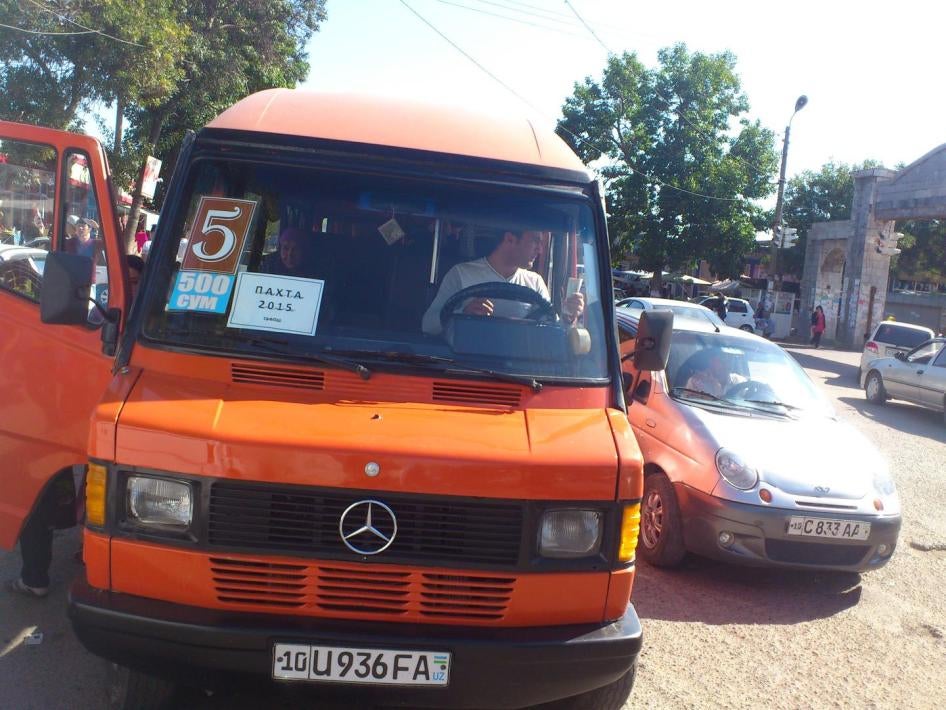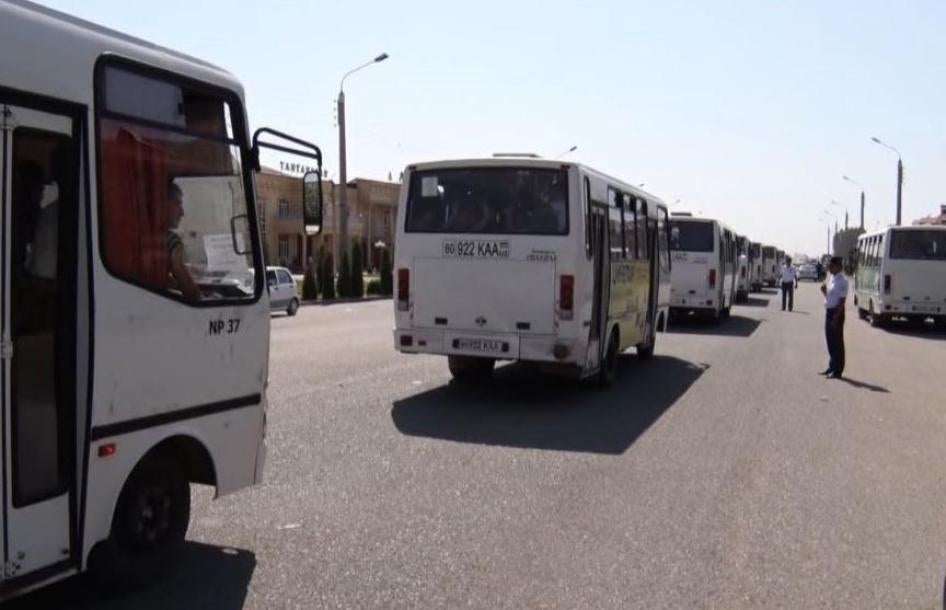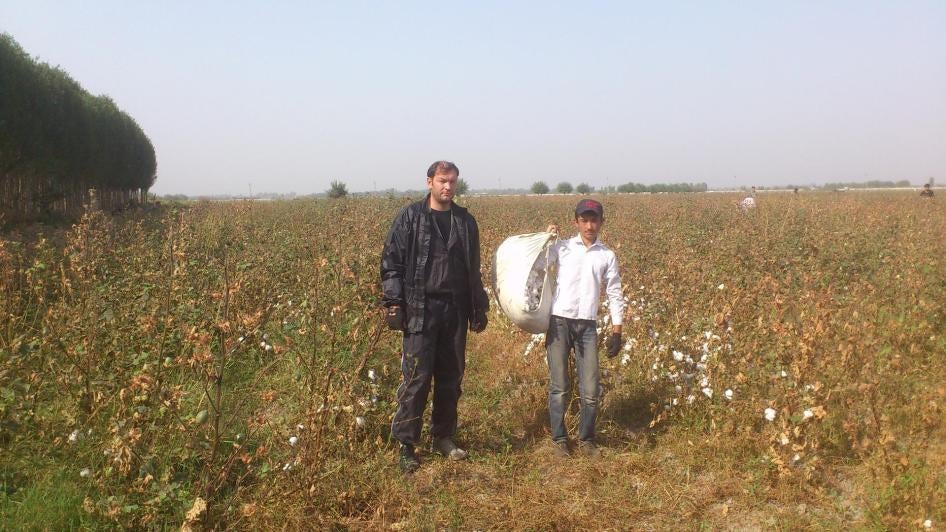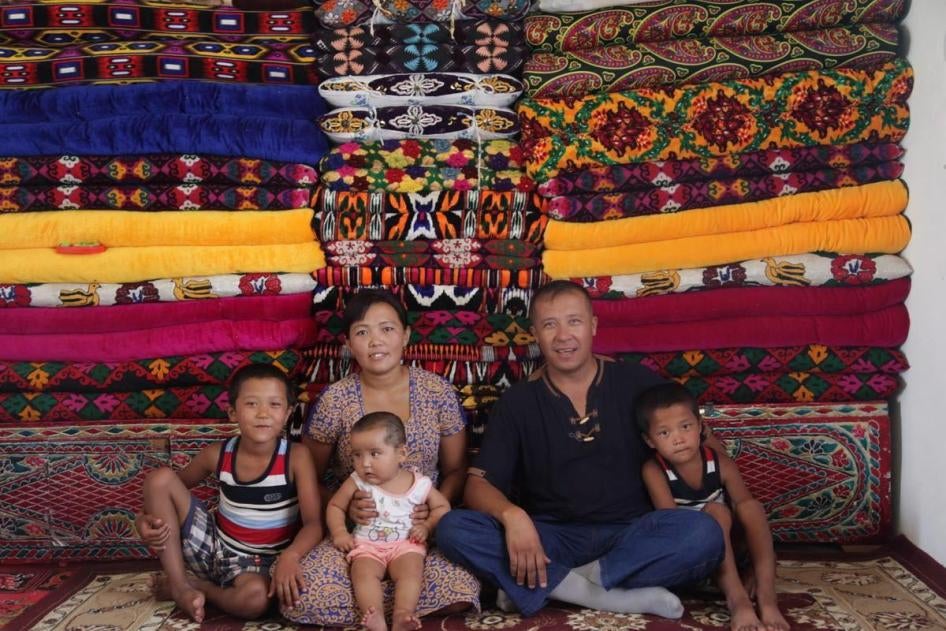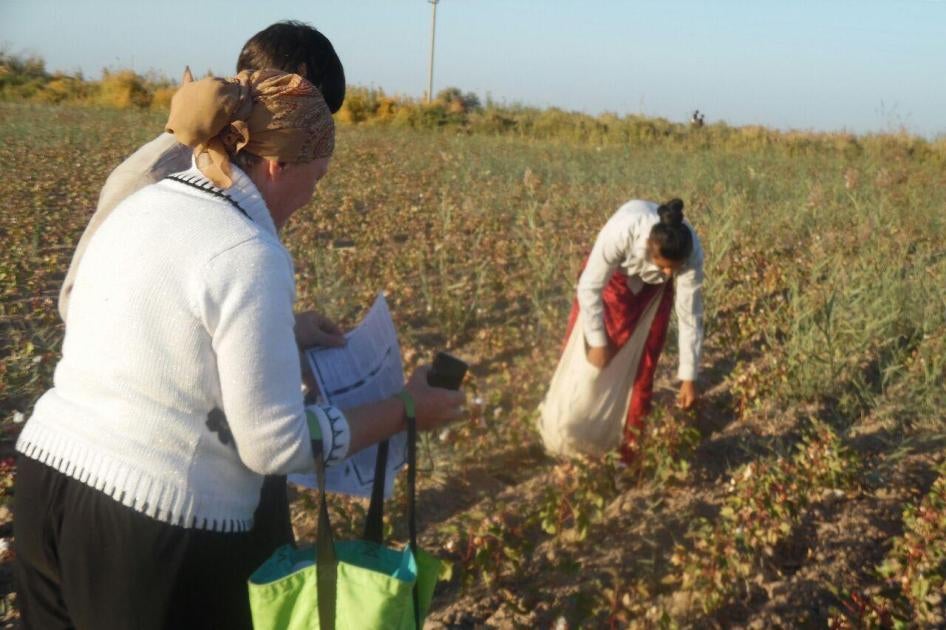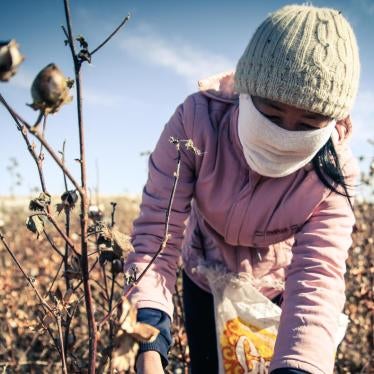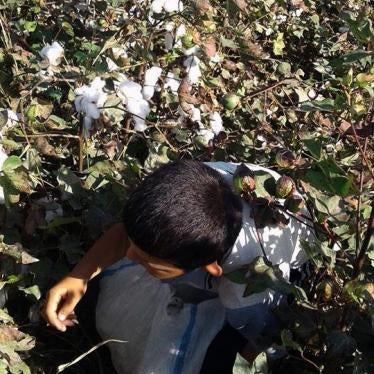Summary
Cotton is mandatory for everyone. The government gave the orders [to pick] and you will not go against those orders…. If I refuse, they will fire me…. We would lose the bread we eat.
−Uzbek schoolteacher, October 2015, Turtkul, Karakalpakstan
For several weeks in the fall of 2015, government officials forced Firuza, a 47-year-old grandmother, to harvest cotton in Turtkul, a district in Uzbekistan’s most western region, the autonomous Republic of Karakalpakstan. The local neighborhood council, the mahalla committee, had threatened to withhold child welfare benefits for her grandson if she did not go to the fields to harvest cotton. These same officials forced another woman, Gulnora, to harvest cotton for the same length of time. Although Gulnora worked, the government refused to pay her child welfare benefits, promising to consider reinstating them if she worked in the fields the next spring. The Uzbek government forces enormous numbers of people to harvest cotton every year through this kind of coercion.
The government’s abusive practices are not confined to adults. During the 2016 harvest the government forced young children to work in the cotton fields. In Ellikkala, a district neighboring Turtkul, officials from at least two schools ordered 13 and 14-year-old children to pick cotton after school. The Uzbek-German Forum for Human Rights saw children working in one of the cotton fields, and a teacher ordering the children to hide. The World Bank has funded an irrigation project in these districts on the condition that the Uzbek government comply with laws prohibiting forced and child labor. Despite this agreement, the Uzbek government has continued to force people, including children, to work within the project area.
Withholding child benefits and other welfare payments is just one of the penalties the government has used to force people to work. The government has threatened to fire people, especially public sector employees who are among the lowest paid in the country. Students who refused to work faced the threat of expulsion, academic penalties, and other consequences. People living in poverty are particularly susceptible to forced labor, as they are unable to risk losing their jobs or welfare benefits by refusing to work and cannot afford to pay people to work in their place.
Based on interviews with victims of forced labor in September to November 2015, April to June and September to November 2016, and early 2017, leaked government documents, and statements by government officials, this report details how the Uzbek government forced students, teachers, medical workers, other government employees, and private-sector employees to harvest cotton in 2015 and 2016, as well as prepare the cotton fields in the spring of 2016. The report documents forced adult and child labor in one World Bank project area and demonstrates that it is highly likely that the Bank’s other agriculture projects in Uzbekistan are linked to ongoing forced labor in light of the systemic nature of the abuses. The report also finds that there is a significant risk of child labor in other Bank agricultural projects in the country.
Uzbekistan is the fifth largest cotton producer in the world. It exports about 60 percent of its raw cotton to China, Bangladesh, Turkey, and Iran. Uzbekistan’s cotton industry generates over US$1 billion in revenue, or about a quarter of the country’s gross domestic product (GDP), from one million tons of cotton fiber annually. These funds go into an opaque extra-budgetary account, the Selkhozfond, housed in the Ministry of Finance, that escapes public scrutiny and is controlled by high-level officials.
Campaigns by a number of groups against forced and child labor in Uzbekistan’s cotton sector have resulted in boycotts of Uzbek cotton. For example, 274 c0mpanies have pledged not to knowingly source cotton from Uzbekistan because of forced and child labor in the sector. Despite this, the World Bank remains active in the country’s agriculture sector providing a total of $518.75 million in loans to the government for projects in this sector in 2015 and 2016.
In Turtkul, Beruni, and Ellikkala districts in Karakalpakstan, the World Bank has worked with the Uzbek government since April 2015 under a $337.43 million irrigation project. Cotton is grown on more than 50 percent of the arable land within this project area. The World Bank secured a commitment from the Uzbek government to comply with national and international forced and child labor laws in the project area and agreed that the loan could be suspended if there was credible evidence of violations.
Since the World Bank approved this project in 2014, the Uzbek government has continued to force people, sometimes children, to work in the cotton sector in Turtkul, Beruni, and Ellikkala, including within the Bank’s project area. Independent groups, including the Uzbek-German Forum for Human Rights, submitted evidence of forced and child labor to the World Bank during and following the 2015 harvest, which runs from early September until early to mid-November annually. Instead of suspending its loan to the government, in line with the 2014 agreement between the two parties, the World Bank increased its investments in Uzbekistan’s agriculture industry through its private sector lending arm, the International Finance Corporation (IFC).
Shortly after the 2015 cotton harvest, the IFC invested in a government joint venture with a subsidiary of Indonesia’s Indorama Corporation, Indorama Kokand Textile, a leading cotton yarn producer in Uzbekistan. In December 2015 the IFC agreed to loan Indorama $40 million to expand its textile plant, which uses solely Uzbek cotton. Given the scale of forced labor in Uzbekistan and its systemic nature, it is highly unlikely that a company could source any significant quantity of cotton from Uzbekistan at present that has not been harvested, at least in part, by forced laborers. There is also a significant risk of child labor.
According to the IFC, Indorama tracks its purchases from sites where cotton is processed to mitigate the risk of child and forced labor. Together with the IFC, Indorama has developed a system for rating the risk level of districts in which gins are located. But this system is deeply inadequate. The IFC’s Environmental and Social Performance Standards, which are designed to prevent the IFC from investing in projects that harm people or the environment, require clients to identify risks of, monitor for, and remedy forced and child labor in their supply chains. The Performance Standards provide that where remedy is not possible, clients must shift the project’s primary supply chain over time to suppliers that can demonstrate that they do not employ forced and child labor.
The World Bank is also heavily invested in the country’s education sector, where forced and child labor have undermined access to education, and its quality, because teachers, and students, including children, have had to leave school for up to several months to work in cotton fields. Through direct funding and the Global Partnership for Education, a multistakeholder funding platform, the World Bank provides almost $100 million in financing for education projects in Uzbekistan.
The government has greatly reduced the number of children it forces to work since 2013, primarily by ordering government officials down the line of command to mobilize adults rather than children. However, Human Rights Watch and the Uzbek-German Forum documented more cases of state-organized child labor through schools mobilizing children in 2016 than in the previous year. For example, in addition to child labor in Karakalpakstan described above, in 2016 children and teachers in two districts in Kashkadarya and a school employee in rural Fergana told Human Rights Watch and the Uzbek-German Forum that local officials required schools to mobilize children as young as 10 or 11 years old to pick cotton and suspended classes during this period. They noted that in several districts this was worse than 2015, when children received some classes prior to being sent to pick cotton.
The World Bank’s Unsuccessful “Mitigation” of Forced Labor
The World Bank has a long history of investing in Uzbekistan’s agriculture sector, but a poor record of addressing forced and child labor in the projects it funds. The Bank only acknowledged this problem after forced laborers filed a complaint with the World Bank’s independent accountability mechanism, the Inspection Panel, in 2013. Thatcomplaint alleged that a Bank agriculture project was contributing to the perpetuation of forced and child labor in Uzbekistan.
In response, the World Bank introduced several measures to mitigate the risk of these labor abuses being linked to existing and proposed Bank projects. It required the government to comply with national and international laws on forced and child labor. It also committed to establish third party monitoring of labor practices in the Bank’s project areas and to implement a grievance mechanism through which victims of forced labor would be able to complain and receive some redress. These mitigation measures do not adequately address government-organized, systematic forced labor in Uzbekistan’s cotton sector. Ultimately, the Bank found that it could not implement some of its commitments, so it settled for weaker measures.
For example, the World Bank contracted the International Labour Organization (ILO), a tripartite UN agency made up of governments, employer organizations, and worker representatives, to monitor forced and child labor in partnership with the Uzbek government, instead of independently monitoring the government’s practices. The ILO has an important role to play in promoting fundamental labor rights in Uzbekistan. However, it allowed the involvement of government and government-aligned organizations in the monitoring effort. The lack of independence of labor unions in Uzbekistan further compromises the ILO’s work in Uzbekistan. Under this structure, in reality, the government that mandates forced labor and utilizes child labor is allowed to monitor itself. While the World Bank has acknowledged these limitations privately, publicly it continues to refer to the ILO as undertaking “independent monitoring.”
The credibility of the ILO’s findings has been further undermined by evidence that the government coached ILO interviewees. The ILO reported that “Many interviewees appeared to have been briefed in advance.” Numerous people told Human Rights Watch and the Uzbek-German Forum that government officials or their supervisors told people to say they were local and unemployed, picking cotton voluntarily, or that they worked as cleaners or guards in their schools and hospitals instead of teachers and medical staff. If the monitors already knew that they were teachers, then they were to say that they voluntarily picked cotton after they had finished teaching classes.
There is no proper grievance mechanism either. Instead of an independent mechanism, the Ministry of Labor and a government-controlled trade union federation are responsible for obtaining feedback from workers, undermining its credibility among workers. This system has resulted in reprisals against complainants and a general dismissal of their concerns, both of which have compounded the lack of trust in the mechanism.
The World Bank has not recognized that Uzbekistan has breached its loan agreements with the Bank in continuing to force adults and some children to work in its project area, despite receiving evidence from independent groups including Human Rights Watch and the Uzbek-German Forum of these abuses. The ILO similarly reported to the World Bank that it observed indicators of forced labor in the country in 2015 and that there were ongoing risks of forced labor in 2016 including in Bank project areas.
Instead of suspending key loans to Uzbekistan, the World Bank has lauded the government for its efforts, saying, “The government is taking actions, albeit in a very incremental and cautious manner, that reflect a genuine commitment to abide by its national laws and international commitments.” Bank staff have pointed to legal changes, the government’s cooperation with the ILO, increased training on forced and child labor, the promise of mechanization, the government’s commitment to reduce the land on which it requires farmers to grow cotton, and reports that at least one government official was dismissed for violating forced and/or child labor laws in November 2016. The Bank also noted that, according to the ILO, the number of people that refused to work in the cotton harvest doubled from 2014 to 2015. While these are notable developments, none of these steps directly addressed the fact that forced and child labor continue to be linked to Bank-supported projects in violation of the Bank’s agreements with the Uzbek government.
Threats and Reprisals Against Human Rights Defenders
The Uzbek-German Forum’s monitors, as well as other people conducting human rights and labor rights monitoring work, faced constant risk of harassment and persecution in 2015 and 2016. In several regions, local authorities, including police, prosecutors, and representatives of mahalla committees, called in monitors for questioning, accused them of being involved in illegal or “bad” activities, threatened them with charges, loss of jobs, or other penalties, and in some cases confiscated their research materials. Local police and central government officials have also arbitrarily prevented monitors from traveling in connection with their human rights work.
In 2015 this harassment reached unprecedented levels as the government used arbitrary arrest, threats, degrading ill-treatment, and other repressive means to undermine the ability of monitors to conduct research and provide information to the ILO and other international institutions. One monitor, Dmitry Tikhonov, had to flee the country and another, Uktam Pardaev, was imprisoned for two months and released on a suspended sentence. Police told Pardaev that he is subject to travel restrictions and a curfew, although these are not stipulated in the sentence, and have surveilled and intimidated his relatives and friends. He risks going to prison if found to violate conditions of release, which he believes could be used to retaliate against him for speaking out about human rights abuses.
In 2016 only one Uzbek-German Forum monitor, Elena Urlaeva, continued to work openly, and she was subjected to surveillance, harassment, arbitrary detentions and other abuses. On March 1, 2017, police again detained Urlaeva. After reportedly insulting and assaulting her, police sent Urlaeva to a psychiatric hospital for forced treatment. The hospital released her on March 23. Urlaeva said she believes authorities detained her to prevent her from meeting with representatives of the World Bank and the ILO. In Karakalpakstan, where the World Bank irrigation project is being implemented, authorities questioned and intimidated another Uzbek-German Forum monitor, who did not work openly, and amember of his family, suspecting him of monitoring. Security forces also arrested an independent monitor in this area and briefly detained him.
The United Nations Human Rights Committee has raised concerns about forced labor and the treatment of individuals attempting to monitor labor practices in Uzbekistan. Human Rights Watch and others have repeatedly recommended that the Bank include a covenant in loan and financing agreements explicitly allowing independent civil society and journalists unfettered access to monitor forced and child labor, along with other human rights abuses within the Bank’s project areas and to prohibit reprisals against monitors, those that speak to them, or people that lodge complaints. The World Bank refused.
In 2015 and 2016 the World Bank said that it spoke with the Uzbek government about alleged reprisals. Nonetheless, reprisals continued and the Bank has not escalated its response.
The Way Forward for the Government of Uzbekistan
Uzbekistan’s former authoritarian president, Islam Karimov, whose death was reported on September 2, 2016, left a legacy of repression following his 26-year rule. The country’s new president, Shavkat Mirziyoyev, promised increased accountability and acknowledged the lack of reform in key aspects of Uzbekistan’s society, including the economy and the criminal justice system. Despite these statements and the release of several political prisoners, Uzbekistan’s rights record remains atrocious. This leadership change provides a good moment for concerned governments and international financial institutions to press for comprehensive reforms to dismantle Uzbekistan’s forced labor system and provide accountability for past abuses.
Reform of the cotton sector, with its rampant corruption and abusive labor practices, would be a significant step in realizing Mirziyoyev’s promise of accountability. However, Mirziyoyev’s previous positions raise concerns about his credibility. As prime minister from 2003 to 2016 he oversaw the cotton production system, and as the previous governor of Jizzakh and Samarkand, he was in charge of two cotton-producing regions. The 2016 harvest, when Mirziyoyev was acting president and retained control over cotton production, continued to be defined by mass involuntary mobilization of workers under threat of penalty.
As this report outlines, the government can implement immediate reforms to show a real commitment to ending forced labor, including by significantly curtailing forced labor and eliminating child labor in the cotton sector, as well as implementing broader reforms in the agricultural sector to address the root causes of forced labor. Basic steps would include enforcing laws that prohibit the use of forced and child labor, instructing government officials to stop coercing people to work, and allowing independent journalists and human rights defenders to freely monitor the cotton sector without fear of reprisals.
The Way Forward for the World Bank, International Finance Corporation
The World Bank should suspend disbursements in all agriculture and irrigation financing in Uzbekistan until the government fulfills its commitments under World Bank agreements not to utilize forced or child labor in areas where there are Bank-supported projects. The IFC should similarly suspend disbursements to investments in Uzbekistan’s cotton industry until its borrowers can show that they do not source cotton from fields tainted byforced or child labor.
In addition, the World Bank and the IFC should take all necessary measures to prevent reprisals against monitors who document and report on labor conditions or other human rights issues linked, directly or indirectly, to their projects in Uzbekistan. The institutions should closely monitor for reprisals and, should they occur, respond promptly, publicly, and vigorously, including by pressing the government to investigate and hold to account anyone who uses force or threatens persons reporting human rights concerns. They should also independently investigate alleged violations and work to remedy harms suffered from reprisals.
In addition, the World Bank and IFC should publicly and regularly report on reprisals linked in any way to their investments, as well as the actions they took to respond. The Bank should amend its project agreements in Uzbekistan to require the government to allow independent journalists, human rights defenders, and other individuals and organizations access to monitor and report on forced and child labor, along with other human rights abuses in all World Bank Group project areas. The agreements should also require the government to ensure that no one faces reprisals for monitoring human rights violations in project areas, bringing complaints, or engaging with monitors.
Recommendations
To the World Bank
- Suspend all disbursements and future financing to the Uzbek government for agriculture and irrigation projects until the government is not using forced or child labor in World Bank project areas.
- Prior to disbursing any more funds for the relevant agriculture and irrigation projects, require the government of Uzbekistan to:
- Instruct all government officials and citizens that act on behalf of the government not to coerce people and institutions to mobilize forced laborers;
- Allow independent monitoring of the cotton sector, including by journalists, human rights defenders, and other individuals without fear of reprisals; and
- Initiate a time-bound plan to reform root causes of forced and child labor in the agriculture sector, including ensuring national budgets reviewed by the Oliy Majlis include expenditures and income in the agriculture sector.
- Amend existing irrigation, agriculture, and education project agreements to allow independent parties to monitor World Bank project areas and to prohibit reprisals against monitors, people who bring complaints or use the feedback mechanism, and people who engage with monitors. Insist publicly and privately that a condition of financing is that independent human rights defenders, journalists, and other monitors be able to work without impediments or fear of reprisals.
- Engage a third party monitor fully independent from the government to robustly research and report on compliance with core labor conventions in agriculture, irrigation, and education project areas. Such monitoring should:
- Include independent civil society organizations;
- Cover forced and child labor in the cotton sector during the spring field preparation season, as well as in the lead-up to and during the harvest; and
- Cover forced and child labor in the horticulture sector.
- Establish a confidential and accessible grievance mechanism and provide effective remedies, including legal and financial, to any person who is subjected to forced or child labor in the project areas or otherwise linked to the projects.
To the International Finance Corporation (IFC)
- Suspend disbursements to all cotton sector investments in Uzbekistan until borrowers can demonstrate that they do not source from fields where forced or child labor is used.
- Do not fund companies that have produced products using forced or child labor in Uzbekistan until they have changed their practices and remedied past abuses.
- Conduct and publish an independent audit of banks in Uzbekistan receiving World Bank Group funds to determine whether they have:
- forced employees to work in the cotton fields or hire replacement workers; or
- supported or contributed to forced labor, child labor, or other abuses linked to the cotton sector through their investments or conduct.
- Based on this audit, require the banks to implement the necessary reforms.
To the World Bank Group Board of Executive Directors
- Direct World Bank and IFC management to implement the above recommendations and report to the Board quarterly on their progress.
- For any project in Uzbekistan, ensure that an assessment of forced and child labor risk is presented to the Board. Do not approve projects in areas in which forced or child labor are systemic to the very industry the Bank is investing in or investments in companies that have and continue to use products made with forced or child labor.
To the Government of Uzbekistan
- Enforce national laws that prohibit the use of forced and child labor in alignment with ratified ILO conventions.
- Make public, high-level policy statements condemning forced labor, specifically including forced labor in the cotton sector, and making clear that all work should be voluntary and fairly compensated.
- Instruct government officials at all levels and citizens that act on behalf of the government not to use coercion to mobilize anyone to work.
- Allow independent journalists, human rights defenders, and other individuals and organizations to document and report concerns about the use of forced or child labor without fear of reprisals.
- Take immediate steps to provide, in practice, effective protection of independent journalists, human rights defenders, and other activists against any actions that may constitute harassment, persecution, or undue interference in the exercise of their professional activities or of their right to freedom of opinion, expression, and association. Ensure that such acts are thoroughly and independently investigated, prosecuted and sanctioned, and that victims are provided with effective remedies.
- Fully implement ILO Convention No. 87 on Freedom of Association and Protection of the Right to Organise, which the government ratified in October 2016.
- Initiate a time-bound plan to reform root causes of forced labor in the agriculture sector, including:
- Cease punitive measures against farmers for debts and not meeting state-mandated production quotas for cotton and other agricultural products;
- Ensure the state-established procurement prices for cotton and other agricultural products reflect the costs of production, including the cost of voluntary labor at market rates, and, over time abolish the state monopsony on cotton purchasing; and
- Increase financial transparency in the agriculture sector, including by ensuring national budgets reviewed by the Oliy Majlis include expenditures and income in the agriculture sector and ensuring taxes paid in the sector go to the national budget.
To the International Labour Organization (ILO)
- Insist publicly and at the highest levels that independent monitors be able to work unimpeded and safely, highlighting that this is a key indicator of the government’s good faith and a requirement for ILO assistance. Raise concerns about attacks on independent monitors in all ILO reports on Uzbekistan.
- Cease providing a monitoring role for the World Bank, instead focusing on its core mission in Uzbekistan: to promote fundamental labor rights and to devise programs promoting decent work for all.
- Include the International Union of Food, Agricultural, Hotel, Restaurant, Catering, Tobacco and Allied Workers' Associations (IUF), which represents agriculture workers, in discussions planning and developing methodologies for the ILO’s work in Uzbekistan.
To Indorama and Other Textile Companies Operating in Uzbekistan
- Adopt, publish, and implement a clear policy commitment to respect human rights, embedded in all relevant business functions.
- Identify and assess actual and potential adverse human rights impacts in the company’s supply chain and prevent and mitigate adverse impacts, particularly forced and child labor as well as other labor abuses. If the company cannot address the significant risk of forced and child labor in its supply chain in Uzbekistan, cease sourcing cotton from Uzbekistan.
- To avoid perpetuating forced and child labor, ensure that pricing and sourcing contracts adequately reflect the cost to suppliers of labor.
- Establish regular and rigorous internal and third party monitoring in Indorama’s supply chain, including through unannounced inspections. Engage qualified, experienced, and independent monitors trained in labor rights. Include private, confidential interviews with workers, as well as farmers, as components of inspections. Make the results of internal and third party monitoring public.
- Regularly publicly disclose all farms from which cotton is sourced, indicate the level of production, and disclose when the unit was most recently inspected by independent monitors.
- Verify and publicly report whether adverse human rights impacts are addressed.
- Establish a meaningful and effective complaint mechanism whereby people can submit complaints about labor abuses or other human rights violations without fear of reprisal. Ensure that adversely affected people can secure remedy for being subjected to labor abuses or other abuses and receive appropriate protection from reprisals, including legal representation to defend themselves against vexatious lawsuits or criminal complaints filed by the government.
To Commercial Banks Operating in Uzbekistan
- Adopt and implement a clear policy commitment to respect human rights, embedded in all relevant business functions.
- Identify and assess actual and potential adverse human rights impacts in all investments and prevent and mitigate adverse impacts, particularly coercion of farmers, forced and child labor, and other labor abuses. Only provide funding to activities in which the bank can address the significant risk of forced labor or other human rights abuses.
- Do not require employees to harvest cotton or pay for replacement workers.
- Establish regular and rigorous internal and third party monitoring of investments in which there is a risk of forced labor, child labor, or other abuses, including through unannounced inspections. Engage qualified, experienced, and independent monitors trained in labor rights. Include private, confidential interviews with workers, as well as farmers, as components of inspections. Make the results of internal and third party monitoring public.
- Establish a meaningful and effective complaint mechanism whereby people can submit complaints about any concerns about labor or other human rights abuses in the bank’s investments without fear of reprisal. Ensure that adversely affected people can secure remedy for being subjected to labor or other abuses and appropriate protection from retaliation.
Methodology
This report is based on research carried out by the Uzbek-German Forum for Human Rights (Uzbek-German Forum) in Uzbekistan during the 2015 fall cotton harvest, spring cotton planting and weeding season in 2016, and the 2016 fall harvest.
Twenty-two Uzbek-German Forum monitors researched whether there was forced or child labor in Uzbekistan’s cotton fields in the 2015 harvest from September to November, 20 monitors in the 2016 planting and weeding season from April to June, and 18 monitors in the 2016 harvest in the country’s Andijan, Jizzakh, Kashkadarya, Syrdarya, and Tashkent regions, and the Beruni, Ellikkala, Turtkul, districts in the Republic of Karakalpakstan, an autonomous region in Northwestern Uzbekistan, covering 160,000 square kilometers (62,000 square miles). In addition, monitors conducted research in Fergana in 2016, in Bukhara in 2015, and undertook a fact-finding mission to Khorezm in fall 2015. In 2017 Human Rights Watch interviewed seven Uzbeks outside the country, four who worked for the 2016 cotton harvest, one who monitored the harvest, and two who both worked for the harvest and monitored for abuses.
From September to November 2015 the Uzbek-German Forum conducted in-depth interviews in private with 98 people, in May and June 2016 with 63, and from September to December 2016 with 89. Interviewees included schoolteachers, college and university students, farmers, employees of government institutions, including mahalla committees, medical professionals, entrepreneurs, and children. In addition, the Uzbek-German Forum spoke briefly to approximately 400 people during visits to cotton fields, mobilization sites where people gathered to be taken to the fields, and relevant institutions, including schools, colleges, universities, hospitals, clinics, and local government offices in 2015, and approximately 300 people in 2016.
In early to mid-September 2015 and 2016, when the government mobilized the largest number of workers to pick cotton for extended shifts (as opposed to daily shifts close to their homes), the Uzbek-German Forum visited hokimiats (regional and district administrations) and other locations where workers were gathered to be sent to the fields, usually by bus.
In 2015 the Uzbek-German Forum visited five cotton fields in Khorezm, Bukhara, Jizzakh, and Tashkent regions, and six facilities that were being used to house cotton pickers in the Khorezm and Syrdarya regions. In 2016 the Uzbek-German Forum visited 34 cotton fields, including fields in all regions it monitored, and 6 worker housing facilities. The Uzbek-German Forum visited dozens of hospitals and clinics, educational institutions, government establishments, and large markets throughout the 2015 and 2016 cotton harvests.
As a result of government interference in monitoring efforts, several monitors, facing severe reprisals, had to stop their monitoring work. Only one monitor was able to work openly in 2016.
The Uzbek-German Forum also gathered information from documentary sources, including orders signed by directors of enterprises to send workers to the harvest or to weed cotton, decrees by hokims (city mayors and district and regional governors) ordering employees of public institutions to participate in the harvest, ledgers tracking labor mobilization from public institutions, and notes signed by students and others declaring their “voluntary participation in the cotton harvest.” The Uzbek-German Forum also monitored local newspapers and social media posts, and in 2016, posted a request for information about the cotton harvest on the website of Ozodlik, the Uzbek-language service of Radio Free Europe/Radio Liberty. They received more than 50 messages, which were used to corroborate information gathered during interviews.
Interviews conducted by the Uzbek-German Forum were conducted in Uzbek or Russian, without translation. Several of the Uzbek-German Forum’s monitors themselves participated in the cotton harvest, forced by the government in the line of their primary employment. Because of the significant risk of retaliation in Uzbekistan, names have been withheld or replaced by pseudonyms to protect identities throughout this report, and other identifying information has been removed as necessary. In some cases we have removed all identifying information including the region to ensure that those involved are not identifiable.
To explain Uzbekistan’s cotton system, in addition to consulting official sources, Human Rights Watch and the Uzbek-German Forum relied on two key papers that corroborate the Uzbek-German Forum’s field research over the past eight years. The first, “Uzbekistan’s Cotton Sector: Financial Flows and Distribution of Resources,” by Bakhodyr Muradov and Alisher Ilkhamov, is based in part on information provided by a former Uzbek government official writing under the pseudonym Bakhodyr Muradov. This paper provides new information on the cotton financing scheme, flow of resources, and costs of cotton production that has not been published elsewhere. The second is “A Comparative Study of Cotton Production in Kazakhstan and Uzbekistan,” by Anastasiya Shtaltovna and Anna-Katharina Hornidge.
Human Rights Watch and the Uzbek-German Forum met with the World Bank and the International Labour Organization (ILO) on numerous occasions over the past several years, often together with other representatives from the Cotton Campaign, a global coalition of human rights, labor, investor, and business organizations dedicated to eradicating forced and child labor in cotton production. Relevant information obtained from these meetings is reflected in this report.
Human Rights Watch and the Uzbek-German Forum wrote to the World Bank, the IFC, the government of Uzbekistan, the ILO, and Indorama on August 15, 2016 and in May 2017, as well as Hamkorbank, and Asaka Bank on August 15, 2016 seeking their response to the findings of this report. All the letters are online at https://www.hrw.org/news/2017/06/06/we-cant-refuse-pick-cotton-uzbekistan-report-letters.
Indorama and Hamkorbank responded to our letters but declined to directly answer our questions. Indorama’s responses are integrated throughout this report. Human Rights Watch and the Uzbek-German Forum met the World Bank and IFC in September 2016; information provided by the two organizations is integrated throughout the report. The government of Uzbekistan, ILO, and Asaka Bank did not respond to our letters.
Glossary of Terms and Abbreviations
|
College |
Equivalent to high school in the United States. Students attend for three years, usually from 16-18 years old. |
|
Cotton gin |
A machine that separates cotton seeds from cotton fibers. The term also refers to the state-controlled cotton association that is responsible for raw cotton procurement and ginning. |
|
Hokim |
Head of city, district, or regional administration, similar to a mayor or governor. The same term is used for all levels of government. |
|
Hokimiat |
City, district, or regional administration. The same term is used at all levels. |
|
IFC |
International Finance Corporation, an arm of the World Bank Group that finances and provides advice for private sector ventures in developing countries. |
|
ILO |
International Labour Organization, a tripartite UN agency made up of governments, employer organizations, and worker representatives. |
|
Khashar |
Uzbek tradition of community service whereby community members engage in “voluntary mutual support,” for example, helping each other with farm work or building a new house. |
|
Mahalla |
Neighborhood or local community, which can refer to the physical location, a community, or a state administrative unit. |
|
Mahalla committee |
A form of local self-government in practice directed by and financially dependent on the district and city hokimiat. |
|
RESP II |
World Bank financed Rural Enterprise Support Project Phase II, which funded the government to provide financing to farmers and agribusinesses through commercial banks from 2008 until December 31, 2016. |
|
Selkhozfond |
Fund housed in the Ministry of Finance responsible for payments for agricultural production, purchasing, and sales. |
|
Soum |
Uzbek currency |
|
World Bank |
The public sector lending arms of the World Bank Group, the International Bank for Reconstruction and Development, and the International Development Association. |
|
World Bank Group |
The World Bank Group consists of the International Bank for Reconstruction and Development, the International Development Association, the International Finance Corporation, the Multilateral Investment Guarantee Agency, and the International Centre for Settlement of Investment Disputes. |
I. Uzbekistan’s Cotton System and the World Bank
Uzbekistan’s Cotton System, Forced Labor, and Past Concerns of Widespread Child Labor
The Uzbek government exerts direct control over the cotton sector from the top down, with officials at every level involved in implementing the forced labor system.[1] Annually the government forces citizens to prepare cotton fields and pick cotton, and farmers to deliver production quotas, all under threat of penalty. A 2014 presidential decree illustrates the close involvement of high-level central government officials in cotton production and harvesting. The decree gives personal responsibility for the harvest to key central officials and regional and district governors, and gives the prime minister authority for the decree’s execution.[2]
Top officials set the national cotton production target each year.[3] The prime minister issues quotas to the regional hokims, or governors, who, with the state-controlled cotton association, responsible for raw cotton procurement and ginning, impose productionquotas on farmers through their land lease agreements and procurement contracts.[4] Farmers, who do not own their land but lease it from the government, are obligated to sell cotton to one of the state-controlled gins at the state price.[5] The Ministry of Finance sets the price paid to farmers below the government’s own estimate of production costs.[6] The government also sets the rates paid to pickers, which are substantially lower than market wages.[7]
The government controls the inputs for cotton production through joint-stock companies, which are co-owned by the government and individuals.[8] These companies have a monopoly over each input or service needed for cotton production. The Ministry of Finance controls the flow of expenditures and income for cotton and cotton seed production through a cashless system of credit managed by the agricultural fund, called the Selkhozfond. According to a credible study of the financial flows of the cotton industry, the Selkhozfond, housed in the Ministry of Finance and controlled by high-level officials, does not publicly report income or expenditures.[9]
The Selkhozfond transfers funds into designated accounts for cotton production at commercial banks and disburses to farmers’ accounts according to the farmer’s purchase contract. Rather than providing cash, banks record payments to the accounts of input suppliers on behalf of farmers.[10] Following the harvest, the Selkhozfond pays farmers for the cotton delivered to state-controlled gins by depositing money into their accounts that must be used to repay the banks, including for interest, before it is used for any other purpose.[11]
Under the authority of the central government and with the support of the commercial banks, officials enforce production quotas assigned to farmers and debts owed by farmers to the government via the banks by confiscating farmers’ land and other property, bringing criminal charges, and using physical and verbal abuse against farmers.[12] In 2015 the government launched an agricultural “re-optimization” plan to reduce the size of agricultural land allotments and to take over land of farmers who failed to meet cotton quotas.[13] It also implemented a plan known as “Cleaver” (Oibolta in Uzbek), under which local officials repossessed the land and possessions of farmers who had failed to meet production quotas for cotton or wheat or incurred debts.[14] The plan and other punitive measures continued in 2016.[15]
On a conference call with local authorities and farmers on October 12, 2015, then-Prime Minister Mirziyoyev ordered local officials to use court bailiffs and police to take property from indebted farmers. A farmer who was on the call told Radio Ozodlik that the prime minister said, “Go to the homes of farmers in debt, who can’t repay their credit, take their cars, livestock, and if there are none, take the slate from their roofs!”[16] In 2016 farmers told the Uzbek-German Forum that they would again face consequences for failure to meet their daily harvest and annual cotton production quotas.[17] One farmer, who only fulfilled 70 percent of his cotton quota in 2016, said, “They will use Shavkat Mirziyoyev’s ‘Cleaver’ regime against me. It was like that last year. I had to sell all my livestock and turn in [the money] instead of cotton.”[18]
The government also appeared to assign new penalties to farmers who fail to meet cotton production quotas in effect for contracts signed as of July 20, 2016. The Uzbek-German Forum obtained a copy of a “Warning Letter” sent to cotton farmers which states that they will be subject to a court proceeding for failure to fulfill the production requirements as well as incur personal financial liability for credit advanced.[19]
The prime minister oversees implementation of the cotton production plan, including through regular conference calls with regional officials and farmers.[20] Regional and local hokims bear responsibility for mobilizing labor to harvest cotton and perform spring fieldwork.[21] These officials, in turn, impose mobilization quotas on public sector officials, such as the heads of the regional and local departments of education and health, and heads of enterprises, to mobilize workers from their sectors. Department heads allocate quotas to school, college, university, and hospital directors who, in turn, require their employees and students, in the case of colleges, universities, and some schools, to perform cotton work.[22] Officials also impose recruitment and harvesting quotas on mahalla, or neighborhood council committees.[23] Officials at every level risk losing their jobs if they fail to deliver their quotas for labor and cotton, and, in turn, threaten their employees with loss of jobs and other penalties if they refuse to work on the cotton fields.[24]
As discussed below, through this chain of command, the government has forced students, in some cases children, teachers, doctors, nurses, people receiving social welfare, and employees of government agencies and private businesses to the cotton fields, against their will and under threat of penalty. [25]
ILO Committee of Experts’ Concerns
Since 2005, the ILO Committee of Experts on the Application of Conventions and Recommendations has expressed concerns about reports of forced and child labor in the cotton industry and the government’s failure to eliminate it in observations under Conventions 29, 105, and 182.[26] In 2016, the Committee once again urged the government to eliminate the use of compulsory labor of public and private sector workers, as well as students, in cotton farming.[27]
Reduction in Child Labor
Prior to 2014, officials systematically forced children to work in the cotton fields, primarily through school officials, although this practice has diminished following sustained international pressure.[28] Child labor began to decline in 2012 after the European Parliament deferred a textile trade deal with the Uzbek government until ILO observers “confirmed that concrete reforms have been implemented and yielded substantial results in such a way that the practice of forced labour and child labour is effectively in the process of being eradicated....”[29] The reduction of child labor accelerated in 2013 after the US downgraded the country to Tier 3 in the 2013 US Trafficking in Persons report.[30] In 2014 the Uzbek government for the first time did not systematically mobilize 16 and 17-year-old college students to harvest cotton.[31]
World Bank and Uzbekistan
Uzbekistan joined the World Bank in 1992. The Bank’s engagement with Uzbekistan’s agriculture sector began with the 1995 Cotton Sub-Sector Improvement Project, which was aimed at liberalizing cotton prices and privatizing the cotton seed industry.[32] Despite the Uzbek government’s resistance to recommendations to open the government-controlled industry, the Bank has continued lending to the sector.[33] The Bank has only acknowledged and sought to address forced and child labor in the sector in recent years.
Complaint Filed Against the World Bank
In September 2013, victims of forced labor filed a complaint with the World Bank’s independent accountability mechanism, the Inspection Panel, alleging that one of its agriculture investments, Rural Enterprise Support Project II (RESP II), was contributing to forced and child labor.[34] The project funded the government to finance farmers and agribusinesses through commercial banks.[35] The complainants argued that the Bank had not fully recognized and analyzed the problem of forced and child labor and had not put in place adequate measures to prevent Bank funding from being used on agricultural lands on which forced and child labor are practiced.[36]
In its initial report, the Inspection Panel noted that “a plausible link does exist between the project and the alleged harms” of forced and child labor and significant issues of policy compliance.[37] In response, World Bank management promised to implement measures to mitigate risks of perpetuating forced and child labor in its projects. Because of these promises, the Inspection Panel did not undertake a full investigation, viewing the proposed mitigation measures as adequate.[38] The complainants strongly disagreed.[39]
New World Bank Group Investments
Since the 2013 complaint the World Bank Group has increased its financing of agriculture projects in Uzbekistan and in 2015 and 2016 was providing US$518.75 million for irrigation and to finance farmers, through commercial banks, to invest in new technology.[40] In addition, the International Finance Corporation (IFC) has loaned Indorama Kokand Textile, $40 million to expand its textile plant.[41] This project has been subject to a formal complaint with the IFC’s accountability mechanism, discussed below.[42]
II. Evidence of Forced and Child Labor and Links to World Bank Group Projects
During the 2015 and 2016 cotton harvests the Uzbek government required farmers to grow cotton and mobilized students, teachers, medical workers, other government employees, and private-sector employees to harvest cotton, all pursuant to government policy and under threat of penalty. The penalties threatened and imposed by a broad range of state authorities included job loss, loss of child welfare benefits and other welfare payments, academic penalties for students, including expulsion from college or university, and threats of prosecution and violence. Regional and local authorities acted under the authority of the central government and relied on the involvement of many people, including mahalla committee chairpersons, directors of schools, colleges, universities, hospitals and medical centers, private and public enterprises, and government agencies, including the tax authorities, police, and prosecutors.
Child labor continued to be a problem during the cotton harvest, despite significant progress in curtailing it. In 2015 and 2016 some schools forced children as young as 10 and 11 years old to pick cotton. Although the government has made policy commitments and issued orders that children should not work in cotton fields,[43] the intense pressure to fulfill quotas led some officials to resort to child labor.
Section A presents evidence of the ongoing, systematic use of forced labor throughout the country’s cotton sector, emphasizing the involuntary nature of the work and the menace of penalty, the two core components of the definition of forced labor. It also presents evidence of forced child labor in certain regions. World Bank-funded agriculture and irrigation projects are being implemented in 10of Uzbekistan’s 12 regions as well as in Karakalpakstan: Andijan, Bukhara, Fergana, Kashkadarya, Khorezm, Jizzakh,Namangan, Samarkand, Syrdarya, Tashkent.[44] Human Rights Watch and the Uzbek-German Forum documented evidence of forced labor in six of these regions as well as in Karakalpakstan.[45] The World Bank does not publicly report which farms in these regions benefit from Bank-financed projects. Similarly, Indorama, which the IFC has invested in, does not report even in the vaguest terms where in Uzbekistan the cotton it processes is grown.[46] Neither Indorama nor the IFC were willing to disclose the districts where the gins from which Indorama sources cotton are located.[47] Due to the widespread nature of forced labor in Uzbekistan, it is highly likely that the government forced people to work on farms benefiting from World Bank Group projects.
The World Bank is loaning the Uzbek government US$260.79 million to improve irrigation in parts of Beruni, Ellikkala, and Turtkul districts in the autonomous Republic of Karakalpakstan.[48] Farmers are required to grow cotton on a significant portion of farms covered by the project.[49] In section B, below, this report disaggregates evidence on forced and child labor specifically from these districts because the defined project area makes it feasible to document labor abuses directly within the project area and because the government committed to comply with laws on forced and child labor in this area.[50] Human Rights Watch and the Uzbek-German Forum found that officials forced adults and, in some cases children, to pick cotton and weed cotton fields in these districts in violation of the government’s agreements with the World Bank. According to its agreements with the government, the World Bank can suspend this loan uponreceiving credible reports of forced or child labor occurring in the project area.[51]
A. Ongoing Evidence of Systematic Forced Labor and Continuing Child Labor in Uzbekistan’s Cotton Sector
In both the 2015 and 2016 harvests, as in previous years, government officials at all levels oversaw cotton production and harvesting, including ordering the mobilization of workers. According to a regional prosecutor, the Cabinet of Ministers issued a protocol on July 20, 2016, which “decreed to involve all employees in the cotton harvest.”[52] Regional and district officials implemented the central government’s orders by imposing labor mobilization quotas on public institutions for cotton picking during the harvest, as well as for planting and weeding in the spring. In addition to labor quotas, government officials required institutions to meet harvest quotas by picking enough cotton or paying money to cover the shortfall.[53] District hokims and law enforcement officials monitored how many
workers each institution contributed and how much cotton each institution delivered at daily cotton meetings.[54]
Officials threatened, or sometimes punished, heads of institutions that did not meet their quota with disciplinary action and dismissal.[55] Heads of institutions threatened employees and students with dismissal, expulsion, or disciplinary consequences to induce them to work, and heads of mahallas threatened residents with loss of benefits, as described below.[56] Some institutions, especially in the health and education sectors, shut down or operated at reduced capacity during the harvests.[57]
In 2016 a farmer told the Uzbek-German Forum that representatives of the government-owned cotton gins in some regions amended their contracts with farmers.[58] The amendments specify that the farmers accept the obligation to comply with Uzbek laws and international obligations, in particular ILO Convention No. 29 converning Forced or
Compulsory Labour and ILO Convention No. 105 concering Abolition of Forced Labour, when recruiting workers to harvest cotton.[59] Considering the government’s control over the cotton sector, including ordering farmers to produce cotton, setting the price for cotton below production costs, setting the price paid to pickers, and in mobilizing and forcing people to work in the harvest, [60] this raises serious concern that such provisions could be used to scapegoat farmers for the use of forced labor. A farmer explained, “[Pickers] don’t come by the will of the farmer. They come on orders from above.”[61] Some farmers told the Uzbek-German Forum that they do not control mobilization or working conditions and risk penalties for failure to harvest their cotton if they refuse workers while the workers, also under pressure to meet quotas, will simply go to work at another farm.[62]
Extract from Transcript of Cotton Meeting in Khazarasp, KhorezmHokim, Uktam Kurbanov: Cotton! You have to go and pick cotton and fulfill the norm. Is it clear!?.... This policy applies to everyone! If even one person does not go out, it will be bad for you! I’ll shut down your organizations! Everyone, without exception, whether from the hokimiat, tax authorities, the bank or other organizations, all will be shut down. Come on, Bank, answer. Bank Administrator: Boss, all of our workers went to the harvest. Hokim: Then everything is fine, everybody went to the harvest, everything is fine. Bank Administrator: Boss, all of our employees delivered 50 kilograms per day.... A bus with 65 to 70 people leaves to the cotton fields every day. Hokim: The plan has not been fulfilled!.... Everyone should go to the cotton! No one should stay home! Sanitary-Epidemilogical Station.... What’s this? You delivered only 1,286 kilograms? Why is that? I’ll tear your head off! Source: Transcript of Cotton Meeting in Khazarasp, Khorezm, September 29, 2015, on file with Human Rights Watch and the Uzbek-German Forum. A link to the original audio recording is available at http://eltuz.com/ru/glavnye-temy/277/ (accessed May 25, 2017). English transcription is available at http://harvestreport2015.uzbekgermanforum.org/pdf/Local-City-District-Administrations/2015.09.29_Transcript-of-a-Recording-of-a-cotton-headquarters-meeting.pdf (accessed May 25, 2017). |
Field research, official government mobilization decrees and labor tracking ledgers, statements by officials, social media postings, and local media reports indicate that government officials required public institutions to send a large proportion of their employees at a time to pick cotton.[63] Institutions included kindergartens, schools, colleges, universities, local government administrations, clinics, hospitals, and government enterprises. In some institutions, this meant that all employees were sent to pick cotton at some point during the harvest.[64]
The government also required companies and small business owners to provide workers or to pay.[65] For example, in 2016 the Uzbek-German Forum visited three Hamkorbank branches during the cotton harvest. At one branch, the Uzbek-German Forum was advised that about 30 employees of the bank had been sent to pick cotton.[66] At the other two, the Uzbek-German Forum was advised that the bank had paid to avoid sending employees to the cotton fields because to do so would limit the bank’s ability to provide services.[67]
In 2015 the government also ordered the mobilization of third-year college students and university students of all years to harvest cotton, in some cases even when those students were only 17 years old.[68] In 2016 the government continued to mobilize university students of all years, but the Uzbek-German Forum only documented the mobilization of third-year college students in Andijan, Fergana, and Kashkadarya during class time, including some who were 17 years old.[69]
The ILO determined from survey data that 2.8 million people participated in the 2015 harvest.[70] On the basis of this data, the ILO suggests that approximately two-thirds were recruited voluntarily, a “minority recruited involuntarily,” and the remaining were “to some degree reluctant,” due to poor working conditions and wages.[71] Given present conditions, there is every reason to suspect that many of these “reluctant” workers—quite possibly a large majority—cannot be considered voluntary.
Human Rights Watch and the Uzbek-German Forum believe that the number of forced laborers is likely significantly higher than the ILO estimate for the following reasons. First, the ILO’s figures should be read with due regard to the government’s widespread coaching of Uzbek citizens to tell the ILO and others that they participate in the cotton harvest voluntarily.[72] Second, as discussed below, with few exceptions, when interviewed in a confidential setting, people told the Uzbek-German Forum and Human Rights Watch that they did not undertake this work voluntarily, reluctantly, or due to social pressure, but rather because the government required it of them and if they refused, they were told explicitly or reasonably believed they would be punished. It is quite possible that a significant proportion of the people the ILO interviewed did not feel comfortable alleging that they had been forced to work out of fear of reprisal.
Public sector employees, who are among the lowest paid in the country, and people living in poverty are particularly susceptible to forced labor, as they are as they are unable to risk losing their jobs or welfare benefits by refusing to work and cannot afford to pay people to work in their place. Some have personal connections to local officials and are not asked or are excused from working in the cotton fields.[73] A college teacher explained that a few privileged teachers are excused from working in the cotton harvest because they are related to influential government officials, and even the collegе director “can’t talk to them.” “Ordinary teachers” have to pay for a replacement worker or go to the cotton fields, she said. Otherwise “they are dismissed.”[74]
Responses to the ILO’s Conclusion that Most Cotton Pickers are Voluntary, Many Reluctant, Few InvoluntaryHuman Rights Watch shared with several interviewees who had been forced to work in the 2016 cotton harvest the ILO’s conclusion that two-thirds of cotton pickers were voluntary and the remaining were to some degree reluctant, with a minority recruited involuntarily. Below is how some of them responded to this information:
|
Involuntary Labor
While many people may accept cotton picking or spring fieldwork as the “cost” of employment in Uzbekistan, this should not be mistaken for voluntariness. In the vast majority of interviews conducted in private, with a promise of anonymity, people described working in the cotton industry because of state-led coercion, emphasizing the real threats of loss of employment or social welfare benefits, or academic difficulties.[75] With few exceptions, they did not point to patriotism, social pressure, or desire to earn supplemental income as their motivation.[76] One Uzbek-German Forum monitor, who works undercover, spoke of three exceptions.[77] First, replacement workers, who are paid both by those they are replacing and the farmer they are picking for. This often includes unemployed rural residents. Second, people who work for the farmer and those that sublease land from the farmer. Third, a minority of low-paid public sector employees who are efficient cotton pickers and can gather large amounts of cotton, early in the season, resulting in an additional bonus from farmers. In a rare example, a kindergarten teacher explained that while her school director ordered her and her colleagues to pick cotton and told her that she would be punished if she did not, she would still go if she had a choice because she is highly efficient at picking cotton and enjoys it.[78] Most, however, emphasized that they did not pick cotton to supplement their income, but because they were forced.[79]
Cotton is most abundant from early to mid-September, when approximately 75 percent of cotton bolls open. [80] As a result, most voluntary labor occurs during this period, when earning potential is higher and working conditions are better. Thereafter, many workers are able to earn very little and are in the fields involuntarily.[81]
Public sector workers and students emphasized the involuntary nature of their labor in the cotton fields.[82] Unless people had relationships with government officials or the head of
their institution, people who did not wish to pick cotton could only avoid it by directly hiring and paying a replacement worker to pick cotton in their name or by making a payment to an authority, usually a supervisor or administrator.[83] Parents who did not want their children to pick cotton had little recourse and faced threats.[84] When the mother of a third-year college student who was ordered to pick cotton kept him home for two days to help her with domestic chores, the college sent a teacher to bring him back to the fields.[85] Several people emphasized that pregnant women or people who became ill while picking were not exempted from cotton picking.[86] A woman described working in the harvest because her niece, a college student, had become sick after picking cotton for a month.
The student’s parents told the university that their daughter was sick, but teachers visited their home to force her to continue working so her aunt went in the student’s place.[87]
Workers expressed a strong preference to remain at their regular jobs.[88] A former Andijan mahalla official explained,
The government pays your salary so you will pick or you could be asked to give up your post. Now, there is no work ... so you can’t refuse [to pick cotton], you are obligated.... What kind of fool would go to work in the dirt in the cotton fields on a cold day of his own accord instead of sitting inside in a nice warm office? To understand that [picking cotton] is mandatory, you don’t have to be a genius and solve puzzles.... We say, ‘cotton is the people’s khashar [communal work].’ But for real khashar ... you go if you want but if you don’t your neighbor doesn’t threaten ‘you’ll come or else I will do something against you.’[89]
Law enforcement officials supervised the cotton fields, escorted workers, and participated in cotton meetings. Law enforcement, including police, National Security Service (known by its Russian acronym SNB), and prosecutors assisted in mobilizing and supervising workers and enforcing quotas in 2015 and 2016, as in past years.[90] For example, a college teacher said that parents who did not allow their children to pick cotton would have to answer to the prosecutor.[91] A nurse said that police accompanied mahalla officials going house to house to send people to the fields.[92] A police officer threatened to shut down the business of a shopkeeper who refused to pick cotton, telling him he had no right to refuse the government’s orders.[93]
People told Human Rights Watch and the Uzbek-German Forum that law enforcement officials supervised them as they gathered in town centers to be transported to the cotton fields, during the evenings following a day’s work, and in the cotton fields, supervising from a tent (shipon) in the center of the field to ensure that people were working and to help enforce quotas. A kindergarten employee said that she was afraid to use the complaint hotlines because she feared repercussions from the prosecutor, who assisted the hokim in organizing and supervising fieldwork and insulted workers who did not meet the quota.[94] Law enforcement officials also interfered with independent monitors documenting the cotton harvest, including by removing them from fields and destroying notes and photographs.[95]
Penalties and Threats of Penalties for Refusing to Work
Public sector workers, students, and pensioners emphasized that they worked in the cotton fields because they had been threatened with punishment, often explicitly. Even when people did work in the cotton harvest, if they fell short of the required picking quota they were deemed to have not worked hard enough and punished.
University and college directors and teachers threatened students who attempted to refuse to pick cotton or who did not fulfill the picking quota with academic difficulties, including expulsion, and public shaming.[96] Some students and public sector employees were required to sign statements agreeing to pick cotton and to fulfill quotas or agree to suffer expulsion, dismissal, or other sanction.[97] In September 2016 a university student told Human Rights Watch and the Uzbek-German Forum that she refused to pick cotton or hire a replacement worker.[98] After refusing to pay a bribe to one of her teachers, who offered to include her name in the list of cotton pickers for a price, university officials called her daily and sent her numerous text messages pressuring her to “resolve the cotton question,” and threatened to expel her.[99] Because of the pressure, the student eventually paid an unemployed person to work in her place.[100]
A student at another university also received a text message warning, “Respected master’s students! You must resolve your participation in the cotton harvest within one hour. Today we are compiling information and you are at risk of expulsion. Immediately resolve this issue.”[101] Four students in Kokand told a journalist that they were expelled for avoiding the harvest or requesting exemption from cotton picking, in three cases because they needed to work at better-paying jobs to support their families.[102] College and university teachers said they try to scare parents with threats that their children will be expelled or held back a year unless they pick cotton.[103] First-year university students in Jizzakh told the Uzbek-German Forum that university deans threatened them with prison if they refused to pick cotton for the university.[104]
All teachers interviewed by the Uzbek-German Forum said that officials threatened them should they refuse to pick cotton, usually with dismissal.[105] For example, a college teacher from Syrdarya said, “Refusing to pick cotton amounts to giving up your job.”[106] A kindergarten teacher was dismissed because she and her husband were both ordered to pick cotton by their directors for overnight shifts at the same time, which would leave no one at home to care for their children. When she requested to change her shift, her director gave the teacher the choice to go as ordered or pay 700,000 soum (US$106). As she was unable to pay or leave her children, the director forced her to resign.[107]
Healthcare workers similarly picked cotton or paid for replacement workers against their will and under menace of penalty, usually dismissal.[108] A video sent to Ozodlik shows the head nurse at a clinic threatening nurses with dismissal if they fail to pick the daily quota and making them sign statements agreeing to “any action” against them if they fail to meet the quota.[109] Two doctors told the Uzbek-German Forum that authorities ordered medical staff to sign two statements before they went to the fields. The first statement said, “I [name] undertake the obligation to participate in the cotton harvest of my own volition. If I do not fulfill the obligation I have undertaken, I agree to submit to any disciplinary punishment.” The second, which would be used should anyone who refused to pick cotton or hire a replacement worker, said, “I [name] request to resign from my job of my own volition.”[110]
Regional and district officials threaten the heads of institutions with the loss of their jobs if they fail to deliver quotas and the heads of institutions threaten their staff.[111] A school director said that he risked the hokim and education department punishing him: “At cotton meetings we are told to write our resignations if we don't want to pick cotton and can't get our staff to pick.”[112] Another said that the hokim threatened to detain him at the hokimiat that day if he did not turn in one ton of cotton.[113]
Mahalla councils recruited people to pick cotton by threatening to withhold child benefits and other welfare payments, and access to public utilities.[114] A mahalla employee explained, “Every day the mahalla needs to send 60 people to the harvest. The easiest way is to send people who come to the mahalla committee to get necessary papers and forms, [if they refuse to pick,] we refuse to give them the papers. They have no alternative—they are forced to pick.”[115] Another mahalla employee said that officials at the hokimiat told the mahalla employees to threaten to withhold people’s child welfare payments to coerce them to pick cotton.[116] Several women confirmed that they only picked cotton because their mahalla committee had ordered them to and threatened to withhold their child benefits if they refused.[117] Another mahalla committee employee said, “On [name withheld] street, no one went to pick cotton and no one gave any money. People from the electric utility came and cut all the cables between the two poles [on the street], threw them in the truck and drove away.”[118]
Senior management at some businesses also threatened employees with loss of jobs or other disciplinary measures if they refused to pick cotton, and local authorities pressured entrepreneurs to participate in the harvest, threatening them with fines, burdensome inspections, and revocation of licenses.[119] Assia Shatilova, a shopkeeper in Chirchik, in the Tashkent region, told the Uzbek-German Forum that she refused to pay 750,000 soum (US$125) to support the cotton harvest in autumn 2015. She said that in retaliation, on December 29, 2015, local police and tax inspectors, accompanied by the deputy hokim, illegally confiscated 85 million soum (US$14,167) worth of inventory, without any paperwork. She said that an officer shoved her, injuring her. On March 28, 2016, tax inspectors returned to conduct an inspection and confiscated the rest of her inventory, forcing her to close her business and leaving her family without a livelihood.[120]
Ongoing Child Labor
In 2016 children and teachers in two districts in Kashkadarya and a school employee in Fergana told Human Rights Watch and the Uzbek-German Forum that local officials required schools to mobilize children as young as 10 or 11 years old to pick cotton and suspended classes during this period.[121] They noted that in several districts this was worse than 2015, when children received some classes prior to being sent to pick cotton.[122]
- In Yakkabog district, Kashkadarya, children in grades 7-9 (approximately ages 12-14) picked cotton for most of the season, and children in grades 5 and 6 (approximately ages 10-11) picked for more than a month.[123]
- In Shahrisabz district, Kashkadarya, children in grades 6-9 (approximately ages 11-14) picked cotton every day from September 20 to November 1, while children in grade 5 (approximately age 10) picked for 3 or 4 days.[124]
- In Nishon district, Kashkadarya, Radio Ozodlik reported that children in grades 5-9 (approximately ages 10-14) at several schools picked cotton.[125]
- In a rural Fergana school, grade 8 and 9 (approximately ages 13-14) students were forced to pick cotton every day for about a month, while younger students were sent for 15-20 days.[126]
- In Andijan some schools required parents to pick cotton in the place of their children or pay 10,000 soum (US$1.50) per day.[127] A nurse in Andijan said that in her nephew’s school parents could pick cotton for their children or pay for it instead.[128]
In contrast, in Fergana region, one woman said child labor was prohibited on the farms where she picked cotton.[129] Two teachers emphasized that children could not be anywhere near the fields because the ILO inspectors could find out.[130] However, an education worker at a rural Fergana school described being ordered by the school director to force children in grade 5 and older (approximately age 10 and older) to pick cotton.[131]
In 2015, a girl in grade 7 told the Uzbek-German Forum that her school in Andijan sent all children in grades 1-9 (approximately ages 6-14) to pick cotton after school, on weekends, and occasionally suspended class for children to pick cotton.[132] She said that parents picked in place of first-graders.[133] A father in Shahrisabz told the Uzbek-German Forum that schoolteachers ordered children in grade 9, who are usually 14 years old, including his daughter, to pick cotton at first only on weekends, then also on Fridays and, then every day for several hours after classes.[134]
Human Rights Watch and the Uzbek-German Forum documented cases where 16 and 17-year-old college students also picked cotton in Kashkadarya, Jizzakh, Fergana, and Andijan in 2015 and 2016.[135] In many of these cases, officials appeared to resort to child labor to fulfill the college or school’s labor recruitment or harvesting quotas. For example, a college teacher from Jizzakh said that when the college could not fulfill its recruitment quota of third-year students, it supplemented with second-years. The teacher said, “We made up the deficit by sending second-years to the fields in two groups, so it wouldn’t be noticeable. In case the ILO were to come in suddenly, it would look like the second-years were studying.”[136] One college teacher told Human Rights Watch that in 2015, her college only took children to pick cotton after the ILO had completed its inspection.[137] A parent in Jizzakh said that children from the Lyceum (ages 16-18) picked cotton in their teachers’ names.[138]
Education workers emphasized that they were required by their school directors to mobilize students, under great pressure from “higher authorities.”[139] A teacher and a parent questioned the meaningfulness of child labor laws, as the children were still forced to work under orders “from above.”[140] Another teacher said he and his colleagues had to force most of the students to work in the cotton fields.[141] According to a parent, the director of her 17-year-old daughter’s college threatened her when she attempted to refuse to allow her to pick cotton, saying he would report it to her employer—a commercial bank benefiting from IFC support—for disciplinary action.[142]
B. Forced and Child Labor in Beruni, Ellikkala, and Turtkul, Karakalpakstan
Human Rights Watch and the Uzbek-German Forum found that government officials imposed cotton production quotas on farmers and mobilized public sector workers, including school and college teachers and medical workers, and large numbers of third-year college students (who are typically age 18) from Beruni, Ellikkala, and Turtkul districts in Karakalpakstan to harvest cotton in fall 2015 and 2016 under threat of penalty. Regional and district hokims issued quotas for cotton production, harvesting, and labor mobilization to farmers and institutions.[143] Officials from the departments of education and health issued quotas to the directors of schools, colleges, universities, hospitals, and clinics, who, in turn, required their employees and students to pick cotton or pay for a replacement worker.[144] Other local government officials, including mahalla committee members and tax authorities, coerced labor or payments from people receiving benefits and business owners.[145]
Information gathered from visits to colleges, schools, hospitals or clinics, and local administrations, markets, and mobilization sites, and cotton fields in each of the three districts, interviews with 114 people forced to grow, pick, or weed cotton, observation at mobilization sites, and review of local media suggest that the government mobilized thousands of public sector workers at a time, including college teachers, schoolteachers and healthcare workers, for the duration of the 2015 and 2016 harvests in these three districts.[146] These findings are corroborated by official mobilization decrees and government documents that track mobilization and picking quotas from other regions, announcements in local press, and statements by officials, and are consistent with findings in all other regions monitored by the Uzbek-German Forum in 2015 and 2016.[147] During the 2016 harvest the Uzbek-German Forum interviewed and saw several 13 and 14-year-old children harvesting cotton who described working under the direction of their schools, as discussed below.[148]
Public sector workers generally picked cotton in shifts of 10-25 days and in some cases longer, often staying in temporary housing and, after their return, worked daily shifts before or after work and on weekends in addition to their regular jobs.[149] People could avoid picking cotton by paying a replacement worker or sending a relative to pick cotton in their place.[150] Local government officials in all three districts also required some public and private sector businesses to send employees to pick cotton or make payments, purportedly to hire cotton pickers.[151]
Based on 35 interviews with public sector workers people receiving social welfare benefits, and students, including children, the Uzbek-German Forum and Human Rights Watch found that officials also forcibly mobilized a significant number of public sector workers, in particular education and healthcare workers, and, in some cases students, to weed fields and plant cotton in Karakalpakstan from about May 10 until late June 2016.[152] In addition, several teachers and students told the Uzbek-German Forum, as in other areas of the country, that local officials assigned schools and colleges primary responsibility for cotton production on specific land and those institutions faced penalties for failure to produce assigned quota amounts, pressure that led, in some instances, to those institutions resorting to child labor in an attempt to meet their obligations.[153] According to several interviews, mahalla, local neighborhood council, workers went from house to house to recruit people to pick cotton and forced each family receiving child assistance or welfare payments to send one family member, in some cases children, to pick cotton or face cuts to their welfare assistance.[154] Interviewees told the Uzbek-German Forum that people forced to weed fields and plant cotton received no payment for this work.[155]
College Students and College Teachers Forced to Work in Cotton Fields
In 2015 and 2016 government officials, including from the hokimiat and district department of education, mobilized college teachers and third-year college students, who are generally 18, from Beruni, Ellikkala, and Turtkul districts to pick cotton starting in early September, until the end of October and, in a few cases, until early November.[156] In 2015 district education officials mobilized college students for day and overnight shifts; in 2016 district education officials mobilized third-year college students for day shifts only.[157] In addition, some students from Nukus, the capital of Karakalpakstan, were sent to pick cotton on farms in other districts including Turtkul.[158] Classes were suspended for third-year students during this period.[159] Officials also mobilized first and second-year college students, who are generally 16 and 17, to pick cotton on weekends.[160]
While some students were paid, others were not. According to a student and a teacher, in 2015 students from their colleges received no wages for picking: the colleges spent the 230 soum (US$.04) per kilogram allotted by the government on food for pickers, and students who could not meet their picking quotas went into debt.[161] One student said that after the harvest, the teachers bore the responsibility of collecting these debts from students.[162]
Generally, students said the labor was mandatory. Two students in Turtkul told the Uzbek-German Forum that the colleges did not grant students exemptions from cotton picking for any reason and that the only way to avoid picking was to hire a replacement worker at a cost of 200,000-300,000 soum (US$33-50).[163] Another student noted, “No one was released from work, even for good reasons.”[164] Other students said that students could be excused with a doctor’s certificate.[165]
For example, one teacher said that teachers and mahalla committee representatives met with parents who did not want their children to pick cotton to show them the government orders requiring the work.[166] The teacher said that they also required parents to sign written statements that they did not oppose their child working.[167] That account was corroborated by a student who described a similar visit by teachers and mahalla committee members.[168]
Authorities threatened students with expulsion, failing grades, or other academic penalties if they refused to work.[169] One student explained, “Both the teachers and the [college] director say that we won’t get our diplomas if we do not go out to pick cotton.”[170] A college employee emphasized that colleges were under enormous pressure to fulfill their production quotas, which forced them to make students and staff work.[171] One student explained that because of this pressure, “Teachers scold those students who are not coming to pick cotton, [saying], ‘Because of you, the director and I may lose our job.’”[172]
Officials also mobilized college teachers and students for spring weeding work in 2016.[173] Teachers said they would be fired if they refused to work.[174] A student emphasized that neither students nor teachers received any compensation for this work.[175]
Land assignments to colleges
In some cases, government officials also required colleges to produce cotton. A teacher at the Turtkul Industrial-Pedagogical College explained,
Our college took on all aspects of farming on 60 acres. We had the responsibility for planting cotton on that land, weeding it, and had to fulfill [production] quotas. This obligation was ordered by the hokim. Other colleges in Turtkul were also made to take on such obligations.[176]
A staff member at the Turtkul College of Industry and Transportation said that the college was responsible for a whole farm and its production. He said that when the college could not fulfill its quota in 2014, a prosecutor opened a criminal case against at least one staff member. That case was closed only when the college’s staff members paid to buy enoughcotton to make up the shortfall. In 2015 the same thing happened again, the staff member said. He said that the college was only able to fulfill its production plan by 170 staff members giving over half of their monthly salaries to buy cotton.[177]
Two interviewees said that students and staff from both colleges worked from 8 a.m. until past dark each day with no days off. Students from the Turtkul Industrial-Pedagogical College slept at a children’s summer camp and in tents. Each student could go home for one day during the two months to bathe because there were no facilities on the premises.[178]
A college teacher from the Turtkul Industrial-Pedagogical College said that in spring 2016, 50 of the college’s 100 teachers and one-third of the college’s 1500 students weeded the cotton fields on the college’s assigned land, 60 kilometers away in Qumbosgan.[179] In addition, the college teacher said, some teachers were sent to oversee the students, and others were sent to work daily weeding shifts, leaving only a small cadre of teachers available to teach first and second-year students.[180] The teacher said that weeding and picking cotton are “mandatory” because of the college’s land assignment, and that students and teachers worked long hours without compensation and must provide their own food.[181]
Schoolteachers Forced to Work in Cotton Fields
Human Rights Watch and the Uzbek-German Forum documented schoolteachers, including kindergarten teachers, working in cotton fields in Beruni, Ellikkala, and Turtkul during the 2015 and 2016 harvests, as well as schoolteachers working in the fields during the 2016 spring weeding period.[182] Of the 14 schools visited or from which teachers or students were interviewed in 2016, all but one Ellikkala school reported that teachers harvested cotton in 2016.[183]
In general, during the harvest, schools organized teachers into rotating shifts of 15-25 days, with a quarter or more of any one school’s teachers in the fields at a time. Some schools had daily shifts, with some teachers picking cotton in the morning and teaching in the afternoon and others teaching in the morning then picking cotton in the afternoon.[184] School directors mostly mobilized the teachers, under orders from above, and in at least one case the teachers’ union did it.[185] Teachers that had to cover classes while others were in the field had to pick cotton after school and on weekends.[186]
Teachers bore a significant brunt of spring fieldwork in 2016, leaving many schools severely understaffed for the last month of the academic year. In mid-May, local authorities ordered schools to send teachers to weed cotton fields. Schools organized teachers into rotating shifts, each lasting several weeks.[187] A schoolteacher in Turtkul said that half of the school’s 80 teachers were in the fields for weeding. She described the situation as very difficult: “For 20 days we must be 100 kilometers away from our homes. Some of us have small children.”[188] Another schoolteacher in Turtkul reported that of her school’s teaching staff of 80, 30 were sent to the fields for overnight shifts and 20 were also doing daily weeding work.[189] A teacher at a school in Beruni said that the school’s 76 teachers went in groups of 15 teachers for weeding shifts of 10 days each.[190]
Although some teachers said they paid for replacement workers, people interviewed by the Uzbek-German Forum said that the majority picked cotton or weeded the fields themselves, in part because their salaries are too low afford the cost of paying a replacement.[191] One teacher said she was required to hire another worker in 2016, despite the financial hardship, as her director emphasized he needed her to work at the school.[192]
A Department of Education representative told a media outlet that teachers were weeding the cotton fields “voluntarily” because farmers could not cope with the amount of work.[193] However, teachers emphasized to the Uzbek-German Forum the involuntary nature of this work, both during the harvest and the field preparation.[194] An Ellikkala schoolteacher explained, “The order [to pick cotton] came from the hokimiat. There are no teachers who can refuse to pick cotton. We are forced to comply [with the order to pick cotton] as this is government policy....[195]”
A Turtkul schoolteacher told the Uzbek-German Forum that she and her colleagues are too scared to refuse or to complain about the work even though they know forced labor is prohibited and see no value in cotton work. She said that she had never seen anyone refuse to pick cotton.[196] Several workers told the Uzbek-German Forum that their employment contracts did not include provisions requiring agricultural work or any work related to cotton production.[197]
School administrators threatened to fire teachers if they refused to pick cotton or weed the fields.[198] Several teachers told the Uzbek-German Forum that, while it is the school director who requires them to work in the fields, the director is following the orders of the central government.[199] A Turtkul schoolteacher said that while she cannot refuse to work in the cotton fields, nor can the director “refuse to send us.” If he did, she said, “the department of education will fire him.”[200]
In 2015 and 2016 teachers in Turtkul told the Uzbek-German Forum that local officials instructed teachers to lie to labor monitors and tell them that they are picking cotton by their own will.[201] Similarly, a Beruni schoolteacher said that teachers were warned at school meetings not to tell anyone that they participated in cotton weeding work.[202]
Healthcare Workers Forced to Work in Cotton Fields
Government officials forced medical and technical personnel from the Turtkul Central Hospital and the Turtkul Maternity Hospital to pick cotton.[203] In 2015, under orders from the hokimiat, the institutions’ administrators sent hundreds of staff at a time to pick cotton in three waves. The first wave went to the fields on September 3 for 25 days.[204] In 2016 about 700 of the estimated 1,500 medical and technical staff at the Turtkul Central Hospital went to pick cotton for the first 25 day shift, beginning September 5-6.[205] Some employees, who could afford a fee of 300,000-375,000 soum (US$45-63), hired replacement workers.[206] A Turtkul medical worker and nurse said that after returning from overnight picking shifts, staff were then required to pick during the day.[207] A doctor at the central clinic in Turtkul told the Uzbek-German Forum that she picked cotton for 20 days, which was one shift.[208]
The management of the Ellikkala Central Hospital sent 150-170 medical and technical staff to pick cotton for overnight shifts as well as organized remaining staff for daily picking shifts.[209] In 2016 the Beruni Central Hospital also sent staff to pick cotton in rotating shifts, as did district and village medical clinics.[210]
Several nurses from the Turtkul Central Hospital told the Uzbek-German Forum that local authorities again ordered hospital staff to the fields en masse for spring fieldwork. A group of 615 hospital staff went to the fields on May 10, 2016, and had to stay until the next shift came to relieve them on June 9. The nurses complained that they received no additional payment for this work and had to pay for food.[211] One of them described her experience:
Whoever is sent for weeding work lives like homeless people for 20 or 25 days. There are no beds, the floor is dirty, the paint is peeling off the walls.... We walk 30 minutes to the fields, an hour if we’re working in a field farther away.[212]
Medical workers from the Beruni Central Hospital told the Uzbek-German Forum that every department at the hospital had to provide staff members to weed the cotton fields in two shifts, each lasting three weeks to one month, the first from May 10 and the second from June 10.[213] As with other public sector workers, several of the medical personnel interviewed emphasized that they were ordered to do this work and did not do it by choice but understood that it was unavoidable. [214]
Families Forced to Work in the Cotton Fields for Child Benefits, Welfare Payments
In 2015 and 2016 several people told the Uzbek-German Forum that the hokims or mahalla committee required that a family member weed and/or pick cotton if they received child benefits or other welfare payments on pain of possibly losing those benefits.[215] Since October 2016 child welfare benefits amount to 292,000 soum, about US$44 per month, and comprise a significant portion of household income for the rural poor.
In 2015 a woman in Beruni told the Uzbek-German Forum she and others were sent to weed the cotton fields by their mahalla committees and that she was told that she would no longer receive benefits payments for her children unless she did this work.[216] Another woman told the Uzbek-German Forum that she picked cotton in 2015 because her mahalla committee said it was mandatory if she wanted benefits for her baby. Nonetheless, she said, the mahalla committee refused to pay her the benefit and said she would also have to work the next year to get those benefits.[217] Another woman said that she picked cotton because her mahalla committee threatened to withhold the child benefit payment for her grandson.[218] An employee of a public enterprise in Turtkul said that she paid money to her mahalla committee during spring weeding and sent her daughter to pick cotton in 2015 because her daughter-in-law received child benefits and the committee required a family member to work or to pay for a replacement worker.[219]
Public and Private Sector Businesses Required to Provide Workers to Work in Cotton Fields or Pay for Replacement Workers
Government officials, including from the hokimiat and tax authorities, forced private and government businesses, including large and small enterprises and individual entrepreneurs, in the three Karakalpakstan districts to contribute money or labor to the 2015 and 2016 harvests.[220] For example, an employee at a pharmacy in Beruni told the Uzbek-German Forum that officials ordered the pharmacy to send all three of its employees to pick cotton for the season, but that the employees instead contributed money and the pharmacy hired replacement workers.[221]
Tax authorities and other officials required market stall owners, small entrepreneurs, and taxi drivers to send someone to pick cotton or pay 5,000-15,000 soum (US$.75-2.50) per day for replacement workers.[222] The owner of a clothing stall at the central market in Beruni explained, “The bus to the fields picks workers up [from the bazaar]. [But] first the tax inspectors come around to check to see who has paid money.”[223] Other employees of market stalls in Beruni confirmed they had to pick cotton.[224]
A Beruni market stall owner explained that entrepreneurs cannot refuse the orders of tax-department officials to work. She said, “I cannot say no to him. He’d say shut down your shop and go to pick cotton.”[225] Another interviewee similarly noted that “You cannot say no.”[226]
Child Labor
In Ellikkala district, officials from at least two schools ordered 13 and 14-year-old children to pick cotton after school in 2016.[227] The Uzbek-German Forum interviewed several children that it witnessed picking cotton under the supervision of their teachers. Two children told the Uzbek-German Forum that their schools required children younger than them to also pick cotton after school.[228] Similarly, in Beruni district, the Uzbek-German Forum interviewed a schoolteacher whose 12-year-old relative was picking cotton beside her. The schoolteacher said that the child was ordered to pick cotton after finishing her classes at school.[229]
In 2015 and 2016 college officials mobilized 16 and 17-year-old students to harvest cotton. In 2015 interviewees at two Turtkul colleges said that in mid-September both colleges suspended classes and sent second-year students to the fields and sent first-year students, who are generally 16 years old, to pick cotton on Saturdays and Sundays.[230] In 2016 college officials mobilized first and second-year college students at colleges in Beruni, Ellikkala, and Turtkul districts to pick cotton on weekends.[231] On at least one occasion, officials also mobilized first and second- year students at an Ellikkala college to pick cotton on a weekday, Monday September 26, 2016.[232]
Officials forced some students to plant and weed cotton in Karakalpakstan from about May 10 until late June 2016. Several teachers and students told the Uzbek-German Forum that local officials assigned colleges the primary responsibility for cotton production on specific land.[233] Since those institutions faced penalties if they did not meet production quotas, some resorted to child labor to meet the quotas.[234] In several cases children were forced to work in cotton to ensure that their families did not lose their child benefit payments. For example, three children in Beruni and Turtkul, all of whom were 16 years old, told the Uzbek-German Forum that they had been forced to weed the cotton fields in May 2016, prior to the completion of the academic year on May 25. They said that they had been sent by their mahalla committees in order for their families to receive child benefit payments.[235]
In other cases children worked alongside or in the place of their parents.[236] An employee of a public enterprise in Turtkul district said that if one of his colleagues could not go and pick cotton, they sent their children instead.[237]
III. Impact on education
Many schools, colleges, and universities are plagued by crippling closures, disruptions, and teacher shortages for almost a third of the academic year because of the Uzbek government’s forced labor system.
The academic year begins on or around September 1 every year, just as the cotton harvest season begins.[238] The cotton harvest ends in early November, just as the annual November school holiday begins, which lasts until November 10. Many schools, colleges, and universities do not have normal, fully-staffed class schedules until after November 10, or more than two months after school begins. Spring fieldwork begins in late April or early May, depending on the region, and can last well into June. The academic year concludes on May 25, which means that many schools and colleges must prepare students for final exams while a significant number of teachers are weeding the cotton fields.
The World Bank is, directly and through the Global Partnership for Education, financing education projects in Uzbekistan worth almost US$100 million.[239] A significant portion of the World Bank’s funds are for the modernization of general teaching and science laboratories at some of Uzbekistan’s 65 universities, postsecondary institutes, academies, or branches of foreign higher education institutions.[240] The government routinely forces students and teachers at these institutions to work in the cotton sector.[241] In 2015 and 2016, the government ordered some schools, colleges, and universities to mobilize staff, burdening them with both recruiting and fulfilling harvest quotas and creating the appearance of functioning normally. [242]
Falsifying attendance to hide forced labor
According to the ILO, it appears that attendance records are falsified to hide the fact that staff and students are working.[243] Schoolteachers and college instructors told the Uzbek-German Forum they were ordered to falsify records by their supervisors or local education officials to show complete attendance, even as absences and school closures were prevalent.[244] For example, a teacher at a school in Kashkadarya said that the school ledgers reported that all classes and lessons occurred even though half of the teachers and staff were picking cotton and the school was closed entirely for a month while pupils from grades 5-9 (approximately ages 6-14) picked cotton, and stated, “It’s as if the school didn’t close. We are lying to ourselves.”[245]
Disruptions to Colleges
During the 2015 fall harvest, third-year college students, who are usually 18, missed at least two months of class in September and October.[246] In 2016 colleges in some districts continued to send students to pick cotton, while in other districts college students were not mobilized.[247] Classes for first and second-year college students and third-year students were severely disrupted even in institutions where students were not required to pick cotton as significant numbers of teachers and staff were absent for cotton picking, and the remaining teachers often had to do daily picking work in addition to trying to cover classes for their colleagues in the fields.[248] A college teacher in Andijan said that even when first and second-year students continued to come to college: “They would sit looking at each other for two periods and then go home” or clean the college as the teachers were in the fields.[249] A college teacher in Kashkadarya described the impact of these disruptions: “The curriculum is designed for September through May, every single day, every hour is specified. But because of cotton, we can’t comply with the curriculum.”[250]
Undermining Quality of Schools
Closures, false records, and absenteeism of educators and students have undermined the quality of primary, secondary, and higher education in Uzbekistan, as was repeatedly noted by educators.[251] So many teachers are absent that classes are skipped, shortened, or taught by teachers of other disciplines.[252] A Beruni high school teacher explained the situation at her school:
Two months weeding, and then another three months harvesting cotton: because of this, pupils do not receive their full education. Teachers have to conduct lessons in two or three classes simultaneously. For example, the teacher gives some written assignment to one class, and goes to another. Left alone, pupils start making noise. They’re still kids, they cannot learn on their own.[253]
An Andijan schoolteacher emphasized the impact of the forced labor system on education outcomes, “Our students are becoming less and less educated. The situation is the same in colleges. Students who want to continue their education must hire private tutors.”[254]
IV. Reprisals against Human Rights Defenders, Forced Laborers, and Complainants
The Uzbek government severely restricts a range of civil and political rights. It regularly impedes independent civil society groups and retaliates against human rights defenders. This makes independent monitoring of labor practices extremely challenging and dangerous.[255]
Detention of and Reprisals against Human Rights Defenders and Journalists Monitoring Forced Labor Practices
In both 2015 and 2016 several monitors, whose work with the Uzbek-German Forum was not publicly known for security reasons, faced harassment by local authorities. In several regions, police, prosecutors, and representatives of mahalla committees called the Forum’s monitors in for questioning because of their suspected role as monitors.
Officials threatened to file charges against the monitors, put their jobs at risk, and made other threats against them. In some cases the authorities confiscated their research materials or arbitrarily prevented them from traveling in connection with their monitoring work.[256] In 2015 other human rights activists who openly monitored labor practices for the Uzbek-German Forum and who provided information to the ILO and World Bank Group faced harassment and persecution. In some cases the harassment prevented them from conducting their work. This continued in 2016.
Dmitry Tikhonov, a journalist and human rights defender based in Angren, in the Tashkent region, has worked to document labor and other human rights abuses connected to cotton production in Uzbekistan for several years and has regularly provided information to the ILO and World Bank. In December 2015 Tikhonov was forced to flee Uzbekistan after his home office was burned and he faced disorderly conduct and other spurious charges connected to his monitoring.[257] He now resides outside the country, unable to continue his monitoring.
Uktam Pardaev, a human rights defender from the Jizzakh region, for years has advocated on behalf of victims of corruption and monitored the use of child and forced labor in the cotton sector. On January 11, 2016, a court in the Jizzakh region sentenced him to a suspended prison term and three years’ probation for insult, fraud, and taking a bribe, all of which he denies.[258] He had been in detention since his arrest on November 16, 2015.[259] Pardaev says police told him that he must adhere to a curfew, travel restrictions, and refrain from human rights work.[260] Pardaev risks prison if he violates the probation conditions. In August 2015 police “invited” an Uzbek-German Forum monitor to the local prosecutor’s office, where the monitor says he was questioned by an SNB agent about attending a training abroad.[261] The SNB agent told him that they had the right to arrest him for 15 days.
Elena Urlaeva, the head of the Tashkent-based Human Rights Alliance of Uzbekistan and a longtime human rights defender, was arbitrarily detained three times during September 2015 while she was monitoring the cotton sector. Two arrests were with journalist and activist Malohat Eshankulova.[262] On March 9, 2016, Urlaeva was admitted to the Tashkent
City Psychiatric Clinic after ill-treatment by the police during the harvest.[263] The hospital refused to release Urlaeva as planned on May 2, citing “official orders” rather than a medical reason,[264] but finally released her on June 1, following international pressure.[265] After her release Urlaeva said that she has remained under constant police surveillance and that police have prevented people from approaching her for assistance.[266]
In 2016 only Urlaeva and Eshankulova conducted monitoring openly and allege that they suffered frequent harassment, including arbitrary arrest, violence, and destruction of their monitoring information. Urlaeva also reported that she often observed cars parked outside her home, was followed, and that officers from the counterterrorism department visited her home on several occasions to ask about her activities.[267] On October 6, 2016, police in Buka, Tashkent region, arrested Urlaeva, photographer and translator Timur Karpov, and two French journalists when they visited a cotton field. Police wiped Karpov’s phone, which he says he unlocked under physical threat. Police destroyed all information on
Urlaeva’s phone and detained her for 10 hours. She reported that she was beaten in the presence of police by two women and kicked by a uniformed officer while in custody.[268] On October 9, 2016, police in Alat district, Bukhara region, arrested Urlaeva and Eshankulova after they interviewed students picking cotton. Police allegedly strip searched them, detained them for several hours, and destroyed all of their notes and data on their phones and cameras.[269] On October 22 police in Akdarya district, Samarkand region, arrested Urlaeva and Eshankulova when they interviewed doctors picking cotton. Police in Buka arrested Urlaeva again on November 5 when she visited the district Department of Education. She said that after she left the department, a man she did not know forced her into a car, took her phone and and handed her to the police. She alleged that police held her for six hours, searched her, and erased her phone.[270]
On March 1, 2017, police detained Urlaeva once again. After reportedly insulting and assaulting Urlaeva, police reportedly summoned orderlies from a psychiatric hospital who forcibly committed her. A doctor told Urlaeva’s relative that there was a court order for the commitment but did not show it to Urlaeva or her relative.[271] She said that on March 4 doctors began treatment against her will.[272] In a video, Urlaeva said she believed authorities detained her in the hospital to prevent her from meeting with representatives of the ILO, World Bank, and International Trade Union Confederation, scheduled for March 2.[273] The hospital released Urlaeva on March 23, following significant international pressure.[274]
In October 2016 SNB officers in Karakalpakstan detained an indendent monitor who was researching labor abuses in cotton fields benefiting from the World Bank irrigation project. They questioned him for three hours, allegedly releasing him only after seizing the money he was carrying to cover his travel expenses.[275] On November 10, 2016, police in Tashkent detained German journalist Edda Schlager and seized some of her materials, including those containing confidential interview information. They deported her the next day and banned her from returning to Uzbekistan for three years.[276] On November 29, 2016, officials detained, interrogated, and deported Yekaterina Sazhneva, a journalist for the Russian newspaper Moskovsky Komsomolets, the day after she met with Urlaeva, and banned her from returning to Uzbekistan for three years.[277]
On two occasions, officials in Karakalpakstan allegedly detained, interrogated, and threatened the adult daughter of an Uzbek-German Forum monitor. She said that on October 27, 2016, police officers detained her in the fields where she was picking cotton as a replacement worker for someone ordered to pick, several hours after she took photos of other cotton pickers.[278] Police reportedly took her to a police station in Buston, Ellikkala district, where an SNB officer, who said he was from Tashkent, interrogated her. He took her phone, alleging it was stolen. He also showed her a piece of paper, which he said was the statement of the father of a schoolboy whom the monitor had photographed picking cotton but did not let her read it. She said that the officer asked her questions, threatened her children, whose names and ages he knew, with physical violence, and said that her father, the monitor, was harming the nation. The officer allegedly released her and returned her phone after three hours of aggressive questioning and threats, and after requiring her to sign a statement that she had received a warning about the article in the criminal code prohibiting “sowing panic among the population.” She said that as she was walking away, the officer followed her in his car and demanded to check her phone to ensure she had not contacted anyone.[279]
The same woman said that approximately a week after the incident, she was called to the district hokimiat. The same SNB officer was reportedly there, along with another SNB official, a law enforcement official from Nukus, the capital of Karakalpakstan, and two women from the Women’s Committee.[280] The SNB officer from Tashkent again led the interrogation. Over the course of three hours, he allegedly screamed at her, asking if she is “against government policy,” and threatened to harm her children. He showed her the criminal code and said that he could “easily have her sent to prison for several years.”
According to Urlaeva, on September 16, 2016, Khilola Juraeva, an employee of the district department of education in Buka, in the Tashkent region, planned to meet her to provide information about the forced mobilization of education workers. Urlaeva reported that Juraeva called her to cancel the meeting, saying she was being followed and would be punished for passing on the information.[281] On November 7 Urlaeva visited the department and asked to meet with Juraeva. Officials there said that Juraeva had been fired for her previous contact with Urlaeva, but Human Rights Watch and the Uzbek-German Forum could not independently confirm this.[282]
Reprisals against Complainants
- A school director who said she would be punished by the hokim if she could not get her staff to pick cotton said, “I know that you cannot force people to work. But I won’t call the complaint line number we were given. There is no use. These posters are put up for the benefit of the ILO. All these calls [to the hotlines] will result in simple teachers and medical workers losing their jobs.”[283] And indeed, several people who filed complaints with the Federation of Trade Unions of Uzbekistan (FTUU) or Ministry of Labor feedback mechanisms allegedly faced reprisals.[284]
- The Uzbek-German Forum sent a complaint in September 2015, alleging that a regional prosecutor extorted money from education workers in connection with the cotton harvest. The Uzbek-German Forum based the complaint on information it received from a kindergarten director in the region.[285] The director told the Uzbek-German Forum that the prosecutor then gathered the directors of all kindergartens in her district and demanded to know which of them had complained to a human rights organization.[286] In 2016 the director told the Forum that she was too scared to complain again.[287]
- A woman in Kashkadarya who alleges that she was forced to pick cotton or lose her child benefits said her neighbor called the hotline to complain that her 16-year-old daughter was sent to pick cotton overnight. The neighbor told her that in response, local authorities held her for several hours and made her write a statement that she did not oppose her daughter picking cotton. After her neighbor’s experience, the woman said she was afraid to complain herself.[288]
- A teacher said that she sent a complaint to the Ministry of Public Education asking teachers to be freed from mandatory cotton picking: “They called the district department of education and asked them to resolve my issue “peacefully”.... After that, the school director went after me. He started threatening me and said he would show me ‘just what he’s capable of.’”[289]
- On September 30, 2015, human rights defender Dmitry Tikhonov arranged for three people to speak with ILO monitors about their experiences of forced labor. Tikhonov said that police followed him and the complainants to the meeting. The complainants later told Tikhonov that police visited them at their workplace to warn them against talking to international monitors.[290]
V. World Bank Failures
The World Bank only recognized the problem of forced and child labor in Uzbekistan’s cotton sector after an Inspection Panel complaint filed against it in 2013. Since then the Bank’s attempts to mitigate the risk of forced labor have been ineffective.
Forced and child labor still exist in the World Bank’s project areas and undermine its education programs. Yet, the World Bank Group continues to fund these activities. Following the 2015 harvest, during which independent monitors reported abuses, it initiated a multimillion-dollar IFC loan to the Uzbek government’s joint venture with Indorama Corporation, Indorama Kokand Textile, a yarn manufacturer and leading consumer of Uzbek cotton.
The World Bank has opposed adopting safeguards to address retaliation against independent monitors, people who cooperate with them, or people utilizing the feedback mechanisms that the World Bank helped create. At best the Bank has responded to government retaliation with quiet words behind closed doors. Those steps have not had any discernable impact.
Response to Forced Labor in World Bank Project Areas
To mitigate the risk of child and forced labor linked to its projects in Uzbekistan, the World Bank required government compliance with applicable laws and regulations on forced and child labor. [291] Forced labor has continued on a massive scale.
Under the US$337.43 million South Karakalpakstan project agreements, the government must instruct local authorities to ensure strict compliance with laws during the cotton harvest. [292] The World Bank has the right to suspend the project if it has credible evidence that child or forced labor were used within the project area.[293]
Throughout the 2015 and 2016 cotton seasons, the Uzbek-German Forum and Human Rights Watch, together with the Cotton Campaign, repeatedly provided evidence of child and forced labor to the Bank.[294] In 2015 the ILO found indications of ongoing forced labor in the country.[295] The World Bank did not suspend the loan. The Bank noted,
The [ILO] monitoring did not find conclusive evidence that beneficiaries of Bank-supported projects used [forced or child labor] during the 2015 harvest.... However, large-scale state-led mobilization of adults for the cotton harvest did take place in 2015 and is likely to continue in 2016.[296]
In 2016 the ILO did not find specific cases of forced or child labor in World Bank project sites. As discussed below, nor was it looking for such abuses. It did, however, recognize that such abuses were possible because those projects “operate in a similar context and share similar risks of child and forced labor to that of others.”[297] In its press release that accompanied the publication of the report, the Bank emphasized the ILO’s lack of specific cases while downplaying that the ILO’s overall concerns applied equally to Bank project areas.[298]
Human Rights Watch and the Uzbek-German Forum provided further evidence of forced and child labor in the South Karakalpakstan project area to the World Bank on August 15, 2016.[299] Lilia Burunciuc, the Bank’s Central Asia Regional Director, said that the Bank would scrutinize the evidence of forced and child labor laid out in the report to confirm that they are within the project area.[300] She also emphasized that suspending a project would be the last resort, that the Bank is a positive influence on the sector, and that the Bank has made progress in its dialogue with the government on forced labor.[301]
As evidence of its success the Bank cites a high-level government policy commitment to abolish and prevent forced and child labor, and related changes to the law.[302] It highlights reports that at least one government official was dismissed for violating such labor laws in November 2016, public education efforts on the rights of children and adults in schools, and the government’s increased emphasis on horticulture over cotton.[303] The World Bank also notes that, according to the ILO, the number of people that refused to work in the cotton harvest doubled from 2014 to 2015.[304]
Ultimately, the Bank believes that increased mechanization will help eliminate forced labor, requiring fewer people to harvest cotton. But this is of little consequence in South Karakalpakstan, where the Bank’s 2016 status report notes that none of the cotton within the project area had been harvested mechanically, and the 2017 report points out that just five percent was harvested mechanically in the 2016 harvest.[305] The Uzbek-German Forum monitor noted that he did not see any mechanical harvesting of cotton in 2016.[306]
The change in the government’s rhetoric noted by the World Bank is real. In the past the government refused to engage in meaningful conversations about forced and child labor. But changes in practice have been limited, and it is clear that forced and child labor are used in Bank project areas. As such, the projects should be suspended until the government is not using forced or child labor in World Bank project areas.
The Inadequacy of the World Bank’s Mitigation Measures
In its response to the Inspection Panel complaint and in preparation for new projects in 2014, the World Bank proposed measures to mitigate the risk of forced and child labor being linked to existing and proposed Bank projects, including by requiring the government and sub-loan beneficiaries to comply with applicable labor laws and regulations, incorporating these laws in training materials for projects that involved a training component, establishing third party monitoring of labor practices in the Bank’s project areas, and establishing a grievance redress mechanism. While these mitigation measures should be part of the World Bank’s approach, they are not sufficient to address forced labor in Uzbekistan’s cotton sector without the government showing the political will to dismantle its coercive cotton system. Further, some of these measures have proven unfeasible for the Bank to implement in Uzbekistan, so the Bank has proceeded with weaker measures.
Government Required to Ensure Financial Institutions, Farmers Comply with Labor Laws
The World Bank’s financial intermediary projects, the horticulture project,[307] and RESP II provide funding to businesses through banks. The Bank requires farms and related facilities that receive this funding to comply with forced and child labor laws.[308] If a farm is found to have engaged in forced or child labor, the loan will be suspended and terminated, and declared to be immediately payable to the financing institution, which becomes disqualified from participating in the project.[309] That institution is then required to return those funds to the government and that amount will be cancelled from the World Bank loan.[310]
The government and banks are tasked with monitoring for and reporting forced and child labor by beneficiaries.[311] Since government pressure is the reason for these labor rights abuses and the financial institution could lose funding if it finds violations, this creates a perverse incentive to underreport or downplay labor abuses. The World Bank has noted that there “have been no cases of use of child labor in RESP II,” but it has not addressed the inherent conflict at the heart of this monitoring system.[312]
Third Party Monitoring Insufficient, Misleading, Not Independent
Rather than the independent monitoring that the World Bank committed to, the Bank contracted with the ILO to monitor forced and child labor in partnership with the Uzbek government and government-controlled bodies.[313] The state-orchestrated nature of forced labor in Uzbekistan presents an extraordinary challenge to the World Bank-commissioned monitoring, as well as the feedback mechanism, discussed below. The ILO constitutionally works with its member state and the social partners in that state, in this case the government of Uzbekistan and Federation of Trade Unions of Uzbekistan (FTUU) and the Chamber of Commerce and Industry of Uzbekistan, organizations that are not independent of the government.[314]
The FTUU has several times stated publicly that there is no forced labor in Uzbekistan, including in September 2016, as monitoring was underway, and has denied harassment of and reprisals against monitors and human rights defenders.[315] Further, the Uzbek-German Forum has documented cases in which unions played a role organizing mandatory cotton work, including enforcing quotas and collecting payments.[316] People also indicated that they would not speak candidly in the presence of an FTUU official, who they perceive as closely tied to the government or as not representing the interests of workers.[317]
In 2016, rather than using established indicators of forced labor to monitor for abuse, the ILO limited its monitoring to an assessment of how the government’s commitments to address labor abuses were being implemented.[318] The ILO said that this was appropriate because the Uzbek government now implicitly acknowledges that it has a forced labor problem, so the next step is to assess measures to address the problem rather than again document forced labor. When asked what basis it had to conclude that there were no incidences of forced and child labor identified in regards to World Bank-supported projects in that case, the ILO’s chief technical adviser for Uzbekistan said that the ILO would have recognized a child in the field or evidence of forced labor, such as a self-declaration that someone had been forced to work.[319] This conclusion is, at best, of dubious credibility and does not meet the World Bank’s commitment to third party monitoring of labor abuses linked to its projects.
The climate of fear and repression in Uzbekistan makes independent monitoring particularly challenging. Several people expressed fear that something bad would happen to them if they told the ILO about being forced to work.[320] One schoolteacher told Human Rights Watch that the only way people could speak openly was if the ILO interviewed them confidentially, out of the country.[321] As the ILO itself has emphasized, reprisals against labor monitors undermine its ability to monitor.[322]
In 2015 and 2016 educators, medical workers, and others told the Uzbek-German Forum that their supervisors instructed them to lie to inspectors and tell them they were unemployed or non-professional staff such as cleaners and guards, and were picking cotton of their own will.[323] For example, a schoolteacher who picked cotton in 2015 described following the instructions of school officials in telling an ILO monitoring team that teachers did not pick cotton.[324] The ILO has recognized that “Many interviewees appear to have been briefed in advance.”[325] Despite explicitly acknowledging concerns about the integrity of its findings and the possible interference of officials by instructing respondents in advance, the ILO did not explain how these concerns affected its findings. Instead the ILO took the view that the government instructing respondents to tell the ILO they are working voluntarily “has the advantage of raising awareness of the issue of child and forced labour and meant that evidence of measures were to hand.”[326] In addition, some officials appear to have taken steps to hide workers or working conditions from the ILO.[327]
Feedback Mechanism
The World Bank undertook to support the creation of a grievance redress mechanism through which people could anonymously report evidence of forced labor related to Bank projects.[328] According to the Bank, the government insisted that the mechanism be a feedback, rather than redress, mechanism because anagency independent from the government would not have the authority to implement redress measures that fall under the government’s purview.[329] Despite this assertion, the only new mechanisms created sit within the government’s Ministry of Labor and the FTUU. While the World Bank has also pointed to an international feedback mechanism through the ILO, this is merely the existing ILO complaints system that ordinary individuals and NGOs are not eligible to access.[330]
In the context of fear the national feedback mechanism is of limited utility. Many people interviewed by the Uzbek-German Forum who were forced to work said that it was impossible to complain within the repressive environment, that complaining was useless, or expressed concerns that they would face reprisals if they complained.[331] A Beruni schoolteacher said, “I will not complain anywhere. Why? Why should I lose my job?”[332]
The feedback mechanism consists of two call centers managed by the Ministry of Labor and the FTUU, and a website. Of the 2,017 official complaints that the Ministry of Labor received between September 26 and October 31, 2015, 2were officially accepted and subject to further actions and sanctions according to the World Bank.[333] Out of over 1,000 calls, the FTUU registered 68 official complaints related to forced or child labor, labor conditions, and problems with payment and “officially processed and resolved” 19.[334] The Uzbek-German Forum sent 42 notifications of forced labor to the FTUU during this period, copying the ILO but did not receive any replies.[335] In 2016 the Ministry of Labor registered as grievances 30 of the 3,939 “inquiries” it received, identifying 2 as related to child labor and 3 to forced labor.[336] The FTUU deemed 85 of the 1,902 “requests” it received as related to cotton picking. Of these, it confirmed six cases of child labor and two cases as “presenting risks of forced labor,” with the remaining related to poor working conditions.[337] In 2016 the Uzbek-German Forum declined to send notifications to the FTUU, given its poor record of effectiveness and to avoid the possibility of reprisals against complainants.
The World Bank and ILO have recognized some of the limitations of these feedback mechanisms and have been providing technical support to enhance them, which has resulted in some improvements. For example, FTUU can now receive anonymous complaints.[338] However, given the FTUU’s public stance denying the existence of forced labor, the low number of complaints registered and resolved, lack of improvements between 2015 and 2016, and low public confidence in unions or the feedback mechanism, this does not address the structural and contextual problems rendering the mechanism ineffective.
Training of World Bank Beneficiaries on Prohibitions on Child and Forced Labor
Several World Bank projects include financing to train farmers, teachers, and other intended beneficiaries on Uzbek legislation prohibiting forced and child labor.[339] Many of those interviewed for this report, particularly teachers, said they already knew that forced and child labor are prohibited, but since the government forces them to work, the laws are meaningless.[340] A university student said, “I saw the posters about forced labor. But if they aren’t used in practice, what good are they?”[341] People not working in the education sector showed less awareness of the prohibition on forced and child labor in Uzbekistan.[342]
Additional Measures in South Karakalpakstan Project
The World Bank exempted land that this project made arable from the state-assigned cotton production quotas to limit the use of forced and child labor.[343] It also agreed that the amount of the project area on which cotton is produced would not expand.[344] The Bank has not yet evaluated these measures since the project is behind schedule.
World Bank’s Emphasis on Horticulture, Despite Emerging Signs of Forced Labor
As part of the World Bank’s “multi-pronged approach” to addressing forced and child labor, it is promoting crop diversification by supporting Uzbekistan’s horticulture sector. The $183.13 million Horticulture Development Project funds commercial banks and leasing companies to finance horticultural enterprises.[345] The World Bank has pointed to horticulture not being subject to state procurement quotas, operating under a more liberalized market environment, being more profitable, and consequently possibly offering more competitive wages to attract wage labor.[346] But there are concerning signs that this is changing.
In some regions in 2016, government officials began to force public sector workers to assist farmers to plant vegetable crops in addition to forced cotton-related work.[347] This has continued in 2017.[348] An April 2016 presidential decree established a unified system for the cultivation, processing, and purchasing of fruits and vegetables under a system of state holding companies for purchase, processing, storage, and export of fruits and vegetables.[349] Under the new system, farmers will conclude purchase agreements for the processing of fruits and vegetables and receive advances for inputs based on production quotas. The decree also establishes production targets for each region and the amount to be produced by private farms and peasant farms.[350] The government mandated production of four million tons of horticultural products in 2016, meaning that farmers are required to fulfill production quotas for specific crops that they must sell to the government at government-set prices.[351] The government has also increased the penalties farmers must pay for failing to deliver specific crops in specific amounts by dates specified in their contracts.[352] Other sources also reported that in spring 2016 the government ordered a reduction in cotton production and an increase in fruit and vegetable crops.[353]
When this evidence was provided to the World Bank, Animesh Shrivastava, who leads the Bank’s agriculture and water work in Central Asia, said that the Bank is in dialogue with the government on this, but that he is not overly concerned about forced labor because the horticulture system is structurally different to cotton and the government has committed that horticulture products will be sold at a “negotiated market price.”[354] However, a leaked 2017 district administration document lists every farm in the district and the name of a public sector employee assigned to each one who is responsible for planting pumpkins and corn on the edges of the farm’s cotton and wheat fields. The public sector employees listed come from schools, public utilities, and other public sector organizations.[355]
Inadequate Measures to Prevent, Respond to Reprisals
Although it developed safeguards for forced and child labor, the World Bank refused to adopt safeguards to allow independent monitors unfettered access to project sites or to prohibit retaliation against monitors or whistleblowers. Civil society organizations repeatedly told Bank staff that these were critical measures, but staff advised that their legal advisors had told them such covenants were not possible.[356]
Bank staff have expressed concerns about reprisals to civil society and indicated that they have shared these concerns with the government.[357] On occasion, however, Bank staff have declined to raise such concerns.[358] Government reprisals continue and the Bank has not escalated its response, refusing to publicly condemn reprisals or sanction the government in any way. [359]
VI. International Finance Corporation Failures
The International Finance Corporation (IFC), the World Bank Group’s private sector arm, loaned Indorama Kokand Textile, one of Uzbekistan’s leading cotton yarn producers, US$40 million to expand its textile plant in 2015.[360] According to the IFC, the investment allows the company to expand its production capacity, which will increase exports and help to create jobs in the domestic textile sector. [361]
Indorama Kokand Textile is a joint venture between the National Bank of Uzbekistan and PT. Indo-Rama Synthetics Tbk. The major shareholder is Indo-Rama Synthetics Tbk.,a wholly-owned subsidiary of the holding company Indorama Corporation, headquartered in Jakarta, Indonesia.[362] According to its website, Indorama Corporation has committed to “being a responsible corporate citizen and ... [complying] with the best industry and local practices for environment, health, and safety standards.... Every member of our organization ... [is] duty bound not to cause harm.”[363]
The IFC’s Environmental and Social Performance Standards prohibit clients from employing forced and child labor and require them to identify, monitor, and remedy forced labor in their primary supply chain.[364] If they cannot immediately remedy these problems, clients must shift the project’s primary supply chain over time to suppliers that can demonstrate that they do not employ forced labor.[365]
The IFC recognized the loan to Indorama Kokand Textile was a high-risk project “due to potential social risks related to supply chain, namely labor practices in the cotton production sector in Uzbekistan.”[366]
In order to obtain IFC financing, Indorama Kokand Textile committed to:
- Develop and implement a corporate environmental and social policy statement on child labor and forced labor issues in the cotton supply chain;
- Source cotton from areas monitored by the ILO under the World Bank program; and
- Improve its monitoring and tracing of the cotton supply chain, in consultation with the IFC.[367]
Human Rights Watch and the Uzbek-German Forum wrote to the IFC to seek their views about the findings of our investigations and its approach towards its clients.
According to the IFC, Indorama tracks its purchases from cotton gins to mitigate the risk of forced and child labor.[368] Together with the IFC, Indorama has developed a system for rating the risk level of cotton-producing districts based on data from ILO monitoring, publicly available reports on labor abuses, and by examining the number of available laborers in that area. The IFC said that if the risk level of a district rises, Indorama commits to shift to low-risk areas. It had not shifted sourcing at this writing since IFC and Indorama believed it was already only sourcing cotton from “low-risk” districts.
Indorama has not publicly identified where it sources cotton; nor did it provide this information in response to Human Rights Watch and the Uzbek-German Forum’s request for information about its due diligence processes. An IFC staff member justified this secrecy, arguing that as a for-profit company, “there is only a certain amount of time management can spend providing external information.” He also suggested that this information was a “commercial secret.”[369]
This approach is inadequate. Given the scale of the forced labor problem and its systemic nature, it would at best be extremely difficult for any company to source cotton in Uzbekistan while avoiding forced labor entirely. The approach detailed by the IFC relies on the badly flawed ILO monitoring and does not recognize the systematic nature of forced labor within Uzbekistan’s cotton sector. And it does not monitor the farms that grow the cotton Indorama uses, where the bulk of forced labor occurs.
Human Rights Watch and the Uzbek-German Forum wrote to Indorama sharing this conclusion and asking it to describe how it addresses its human rights responsibilities in its operations in Uzbekistan.[370] The company responded:
We are not in a position to comment on the specifics of your internal research. Indorama has a stated policy of not engaging in any form of child and forced labor at any of its facilities globally. We closely work with international organisations to ensure that we remain aligned to our stated policy.[371]
Complaint Filed Against IFC Investments
- On June 30, 2016, a victim of forced labor and Uzbek human rights defenders who have faced reprisals for monitoring and reporting on forced labor filed a complaint with the Compliance Advisor Ombudsman (CAO), the IFC’s accountability mechanism, raising their concerns that the IFC had not undertaken adequate due diligence in these investments and was in violation of the Performance Standards.[372] The complaint, which Human Rights Watch and the Uzbek-German Forum supported, raises concerns about the existence of forced labor in Indorama’s supply chain in violation of Performance Standard 2 and describes how Hamkorbank and Asaka Bank, as commercial banks operating in Uzbekistan, are involved in Uzbekistan’s state-organized cotton labor system, which relies on forced labor. On August 26, 2016, the CAO notified the complainants that it had found the complaint eligible.[373] The assessment process is ongoing.[374]
VII. Human Rights Standards
Both states and the World Bank Group have obligations under international human rights law. Companies, including those that receive money from the International Finance Corporation, have a responsibility to respect human rights, prevent abuses, and remedy human rights abuses that they have contributed to.
International and Uzbek Labor Standards
Forced Labor Defined
Forced labor is prohibited under international law.[375] International Labour Organization (ILO) Convention No. 29 concering Forced or Compulsory Labour, which Uzbekistan ratified in 1992, defines forced or compulsory labor as “all work or service which is exacted from any person under the menace of any penalty and for which the said person has not offered himself voluntarily.”[376] The definition contains three elements: (1) some form of work or service must be provided by the individual concerned to a third party; (2) the work is performed under threat of penalty; and, (3) the work is undertaken involuntarily.
The ILO has elaborated examples of the “menace of penalty” and the “involuntariness” of the labor:
- “Menace of penalty” includes the presence or credible threat of: physical violence against a worker, family members, or close associates; financial penalties including penalties linked to debts, the non-payment of wages, or the loss of wages accompanied by threats of dismissal; denunciation to the police or other authorities; dismissal from current employment; exclusion from future employment; removal of rights and privileges; deprivation of food, shelter or other necessities; shift to even worse working conditions; and loss of social status.[377]
- “Involuntariness” or lack of consent to the labor includes: psychological compulsion, for instance an order to work backed up by a credible threat of a penalty for non-compliance; induced indebtedness, for instance by falsification of accounts, inflated prices, reduced value of goods or services produced, and excessive interest charges; deception or false promises about types and terms of work; withholding or nonpayment of wages; and retention of identity documents or other valuable personal possessions.[378]
In 1957 ILO Convention No. 29 (Forced Labour Convention) was updated through the adoption of Convention No. 105 (Abolition of Forced Labour Convention), which specifically prohibited certain forms of forced labor that were commonly practiced at the time, including the systematic use of forced labor as a “method of mobilising and using labour for purposes of economic development.”[379] The ILO Committee of Experts on the Application of Conventions and Recommendations (Committee of Experts) emphasized that this prohibition applies “even where recourse to forced or compulsory labour as a method of mobilizing and using labour for purposes of economic development is of temporary or exceptional nature.” The Committee of Experts also noted that “no exceptions to universally recognized human rights should be sought in the name of development.”[380]
In its 2015 observation on the application of ILO Convention No. 105 in Uzbekistan, the Committee of Experts clarified that even where a government may claim that work is part of a civic obligation and therefore exempted from the forced labor conventions, “these exceptions are limited to minor works or services performed in the direct interest of the population, and do not include work intended to benefit a wider group or work for purposes of economic development, which is explicitly prohibited by the present Convention.”[381]
Child Labor Defined
Child labor is prohibited under several international conventions, including the ILO Worst Forms of Child Labour Convention, the ILO Minimum Age Convention, and the United Nations (UN) Convention on the Rights of the Child. Uzbekistan has ratified each of these.
ILO Convention No. 182 (Worst Forms of Child Labour Convention) prohibits the worst forms of child labor for children under 18, including “work which, by its nature or the circumstances in which it is carried out, is likely to harm the health, safety or morals of children” (also known as hazardous work).[382] The Convention obliges member states to take immediate action to prevent children from engaging in the worst forms of child labor; to provide direct assistance for the removal of children already engaged in the worst forms of child labor; and to identify and reach out to children at risk.[383]
Although the ILO does not have a specific list of occupations that constitute hazardous work, ILO Recommendation No. 190 (Worst Forms of Child Labour Recommendation) provides guidance to countries on determining what types of work constitute harmful or hazardous work.[384] Each state party to the Worst Forms of Child Labor Convention is expected to use this guidance to identify specific tasks and occupations that it considers hazardous for children. Uzbekistan has included cotton harvesting on its official list of hazardous occupations prohibited for children under the age of 18.[385]
ILO Convention No. 138 (Minimum Age Convention) sets the basic minimum age for employment at 15, and states that children ages 13-15 may participate only in light work that is not likely to be harmful to their health or development or hinder their education.[386]
Uzbekistan has also ratified the Convention on the Rights of the Child, which provides specifically that children have a right “to be protected from economic exploitation and from performing any work that is likely to be hazardous or to interfere with the child's education, or to be harmful to the child's health or physical, mental, spiritual, moral or social development.”[387] Under the convention, governments must take appropriate legislative, administrative, social, and educational measures to protect children from exploitative and hazardous work, including by establishing a minimum age for employment, regulating the hours and conditions of children’s work, and providing for “appropriate penalties or other sanctions to ensure the effective enforcement” of such protections.[388]
Uzbek Law on Child and Forced Labor
Uzbek law, including the Constitution, provisions of the Labor Code, and laws on child protection, generally prohibit forced and child labor.[389] The Administrative Code prohibits officials from imposing compulsory labor on anyone, except as provided by law, an offense punishable by fines, with additional fines for forcing children to work.[390] Forcing people to work can constitute a criminal offense under abuse of authority provisions, punishable by fines or prison.[391] The Constitution guarantees the right to work and to fair labor conditions and prohibits forced labor, and the Labor Code provides that forcing someone to perform work under the threat of any kind of punishment is prohibited.[392] However, Uzbek national law is not fully aligned with ILO forced labor conventions that the government has ratified. The ILO Committee of Experts has advised the Uzbek government to amend article 95 of its Labor Code, having observed that it is used for involuntary transfers of workers from their workplace to the cotton fields.[393]
The World Bank Group and Labor Standards
The World Bank has noted that forced labor exacerbates poverty and is a fundamental abuse of human rights and a violation of international law.[394] It recognizes that child labor prevents children from receiving education and may mentally and physically damage their development.[395] However, until recently the World Bank has not prohibited forced or child labor in public sector projects that it finances. On August 4, 2016, the World Bank finalized a new Environmental and Social Framework, which provides that forced and child labor will not be used in connection with projects that the Bank finances.[396] According to the World Bank, the Framework is expected to go into effect in early 2018.[397] This prohibition applies only to investment lending, which typically involves financing governments to create physical or social infrastructure. It does not apply to the Bank’s other lending instruments, including financing directed at policy or institutional reforms and results-based financing.
While it includes key labor protections and provides for broader social impact analysis, the World Bank does not acknowledge its human rights obligations in the new policy framework.[398] The framework also devolves significant responsibility from the World Bank to its client governments, causing concern as governments are unlikely to identify or address risks related to human rights abuses that they are perpetrating, such as state-organized forced labor or attacks on human rights defenders.
The International Finance Corporation’s Environmental and Social Performance Standards prohibit clients from employing forced or child labor and require clients to identify risks of, monitor for, and remedy forced labor in their primary supply chain.[399] Where remedy is not possible, clients must shift the project’s primary supply chain over time to suppliers that can demonstrate that they do not employ forced or child labor.[400]
World Bank Group’s Human Rights Obligations
As an international organization, the World Bank derives human rights obligations from customary international law and general principles of law.[401] As a UN specialized agency, the World Bank has an obligation to respect and promote human rights and fundamental freedoms for all without distinction as to race, sex, language, or religion.[402] UN member states are obliged under article 103 of the UN Charter to comply with the Charter over other international agreements in the event of a conflict between the two.[403] The International Bill of Rights, which refers to the combination of the Universal Declaration of Human Rights, the International Covenant on Civil and Political Rights, and the International Covenant on Economic, Social, and Cultural Rights, is recognized as the key source used to interpret the rights provisions in the UN Charter.[404]
In addition, each of the World Bank’s member countries has human rights obligations under international law that derive, for example, from treaties to which they are party. As a matter of international law, governments retain all their human rights obligations when they become members of an international organization and therefore cannot abandon them in their capacity as governing members of the Bank.[405] In that capacity, governments are obliged to exercise due diligence with respect to their human rights obligations.[406] According to UN human rights bodies and academics expert in this area, the World Bank’s board of executive directors also has an obligation to ensure that the policies and decisions of the World Bank are consistent with their governments’ human rights obligations, including those obligations derived from human rights treaties that they have ratified.[407]
The Bank’s views on human rights have evolved over the last 15 years. Former Bank General Counsel Roberto Dañino wrote in 2006 that the Bank should “recognize the human rights dimensions of its development policies and activities, since it is now evident that human rights are an intrinsic part of the Bank’s mission.”[408] However, in practice, the World Bank still uses the constraints of its Articles of Agreement to avoid human rights issues that it does not wish to address.[409]
The World Bank’s agreement with the UN states that the Bank operates independently of the UN and that the UN is to refrain from making recommendations regarding particular loans and terms or conditions of financing.[410] As the Tilburg Guiding Principles on World Bank, IMF and Human Rights state, this “provides an organizational independence from the UN, not from international law.”[411]
Companies’ Human Rights Responsibilities
Companies are also the subject of several international human rights standards. In 2008, then-Special Representative of the Secretary-General on the issue of human rights and transnational corporations and other business enterprises John Ruggie elaborated the “Protect, Respect and Remedy” framework for business and human rights, which was further supplemented by a set of “Guiding Principles on Business and Human Rights.”[412] This framework sets out: 1) the state duty to protect human rights, 2) the corporate responsibility to respect human rights, and 3) the need for a remedy for victims of business-related human rights abuses.[413] All businesses should have adequate policies and procedures in place to identify, prevent, mitigate, and account for their impact on human rights. To meet its human rights responsibilities, a company should carefully assess potential human rights risks, including in its supply chain, monitor the impact of its activities on an ongoing basis, seek to prevent or mitigate harm, and adequately address any adverse human rights impacts it causes or to which it has contributed.
Acknowledgments
This report is based on research by 22 Uzbek monitors working with the Uzbek-German Forum for Human Rights under the direction of Umida Niyazova. It was written by Jessica Evans, senior researcher and advocate on international financial institutions at Human Rights Watch and Allison Gill, research and policy consultant at the Uzbek-German Forum for Human Rights.
The report was reviewed and edited by Matthew Fischer-Daly, former coordinator, Cotton Campaign, and Umida Niyazova, executive director, Uzbek-German Forum for Human Rights. It was also reviewed and edited by Hugh Williamson, director, and Steve Swerdlow, researcher, Europe and Central Asia Division; Arvind Ganesan, director, Business and Human Rights Division; Jo Becker, advocacy director, Children’s Rights Division; Chris Albin-Lackey, senior legal advisor; and Babatunde Olugboji, deputy program director, at Human Rights Watch. Additional editorial and production assistance was provided by Amelia Neumayer, business and human rights associate. Research support was also provided by interns Farangiz Abduvahobova, Emily Gabor, Daphne Panayotatos, Ishita Petkar, and Dina Tlis. The report was prepared for publication by Jose Martinez, senior coordinator, and Fitzroy Hepkins, production manager.
Human Rights Watch and the Uzbek-German Forum for Human Rights express their deep gratitude to the individuals and organizations that assisted with this research, particularly activists who have faced reprisals for their work and individuals who are subjected to forced labor. We are also grateful to those external experts who reviewed the report and shared their valuable insights.
Human Rights Watch and the Uzbek-German Forum for Human Rights extend their appreciation to individuals and organizations that have generously supported our work on development and human rights. Human Rights Watch is grateful to the Gieskes-Strijbis Fund for its support of our work in Central Asia.
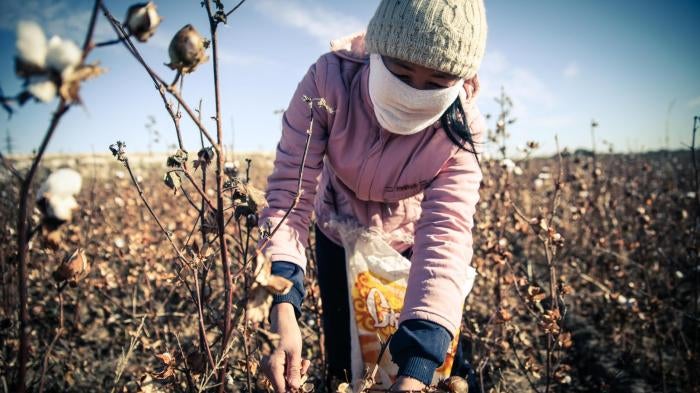

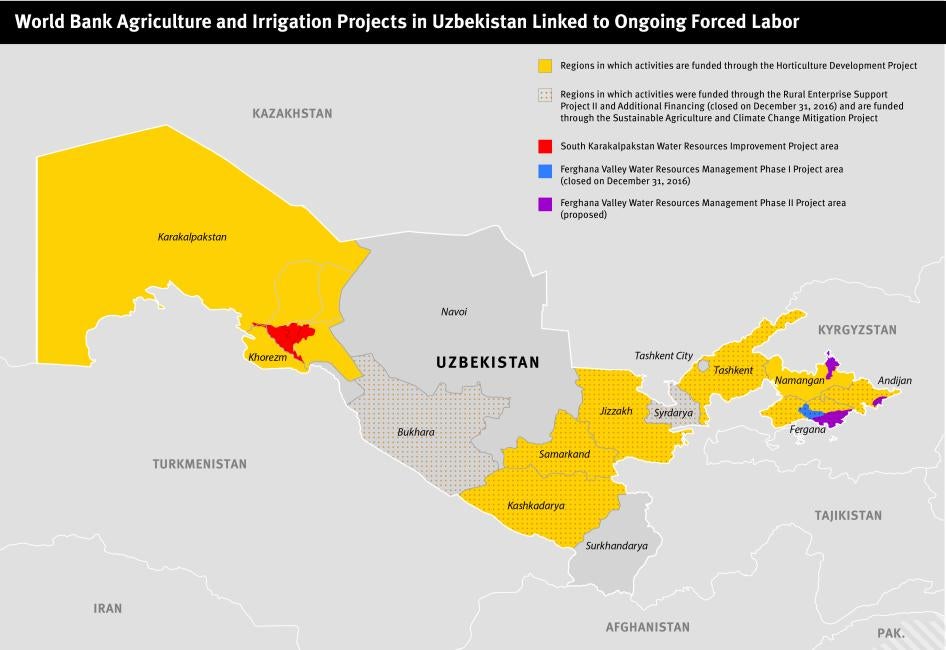
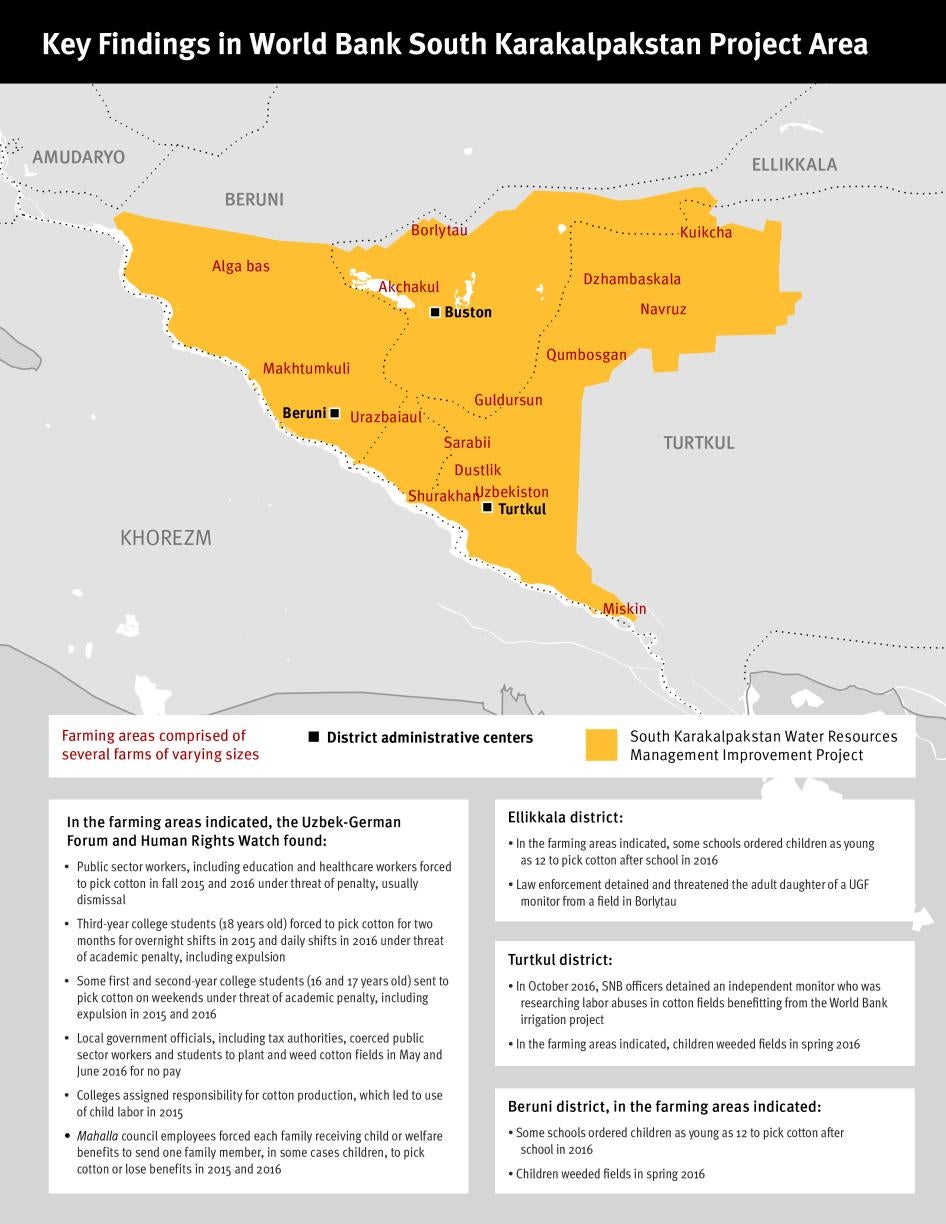
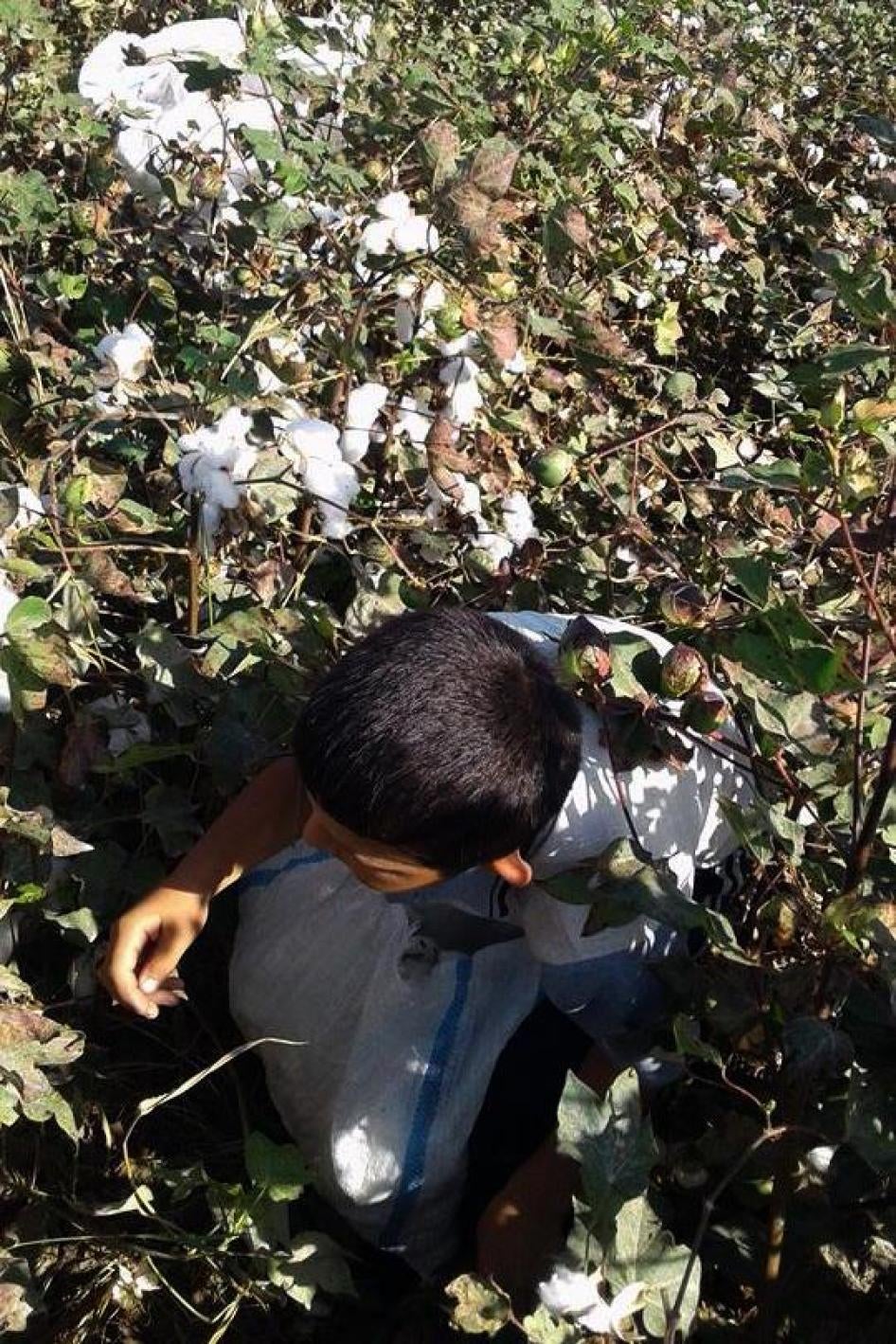
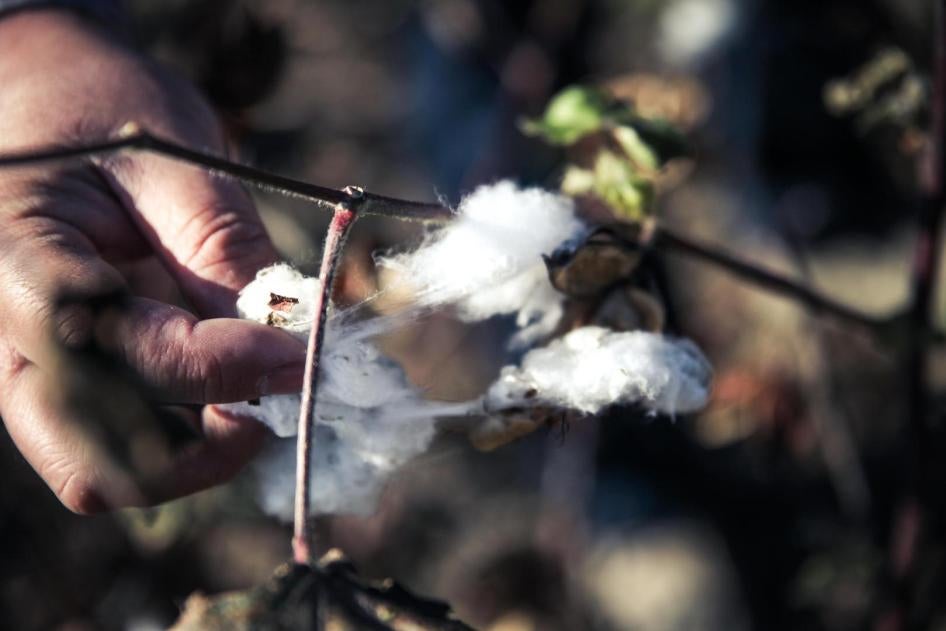
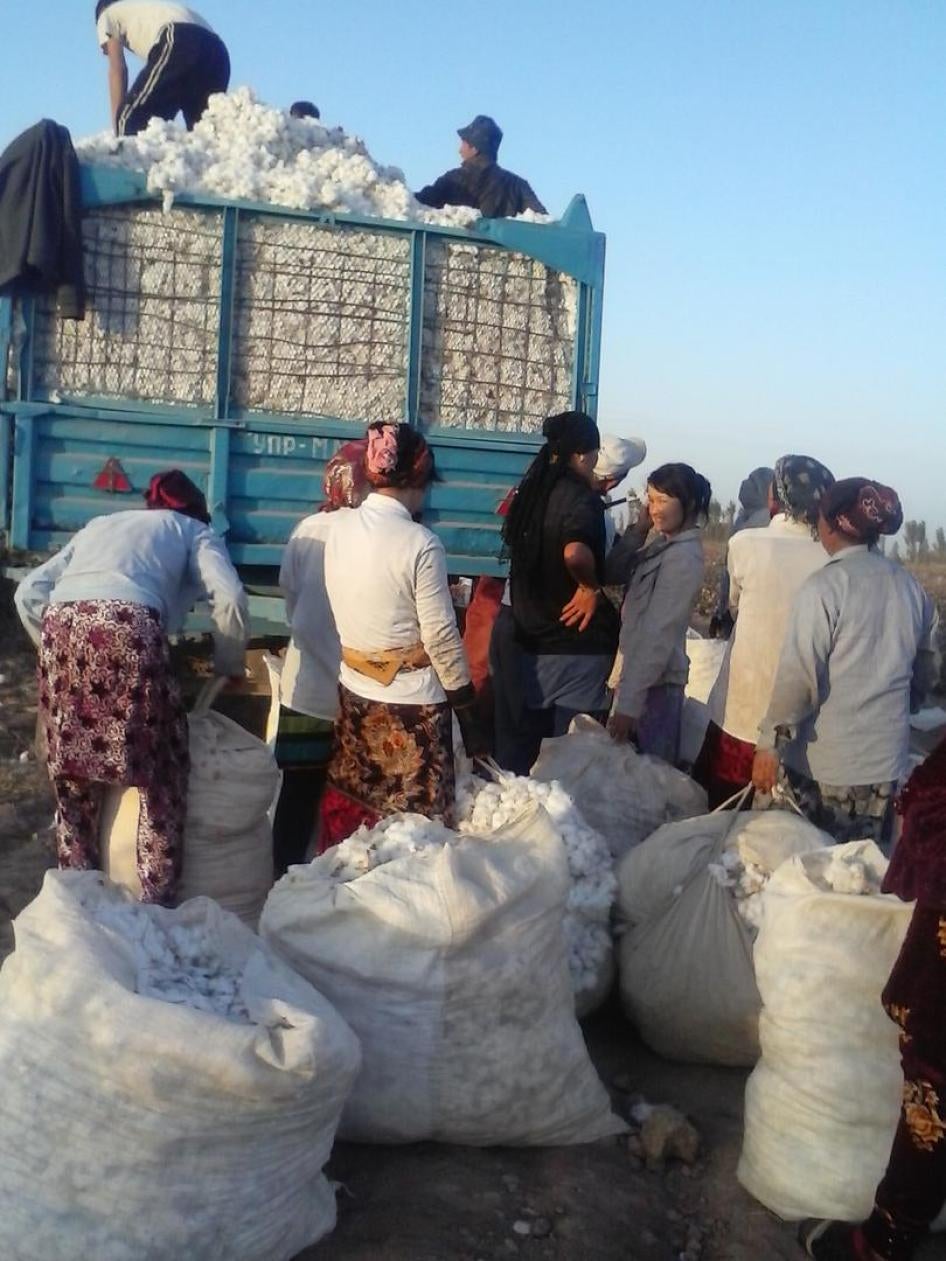
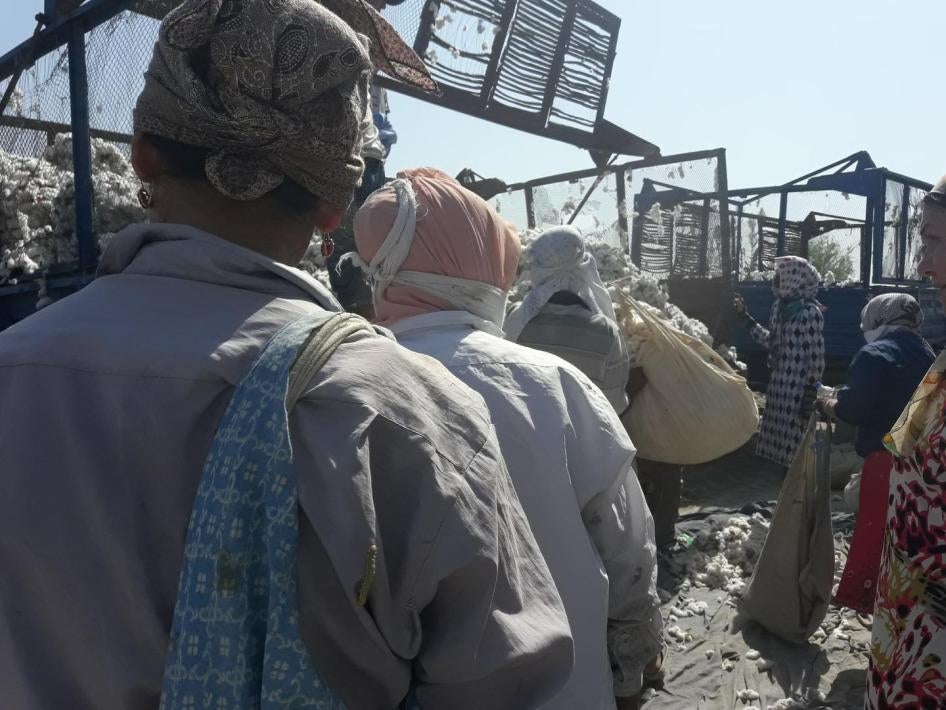
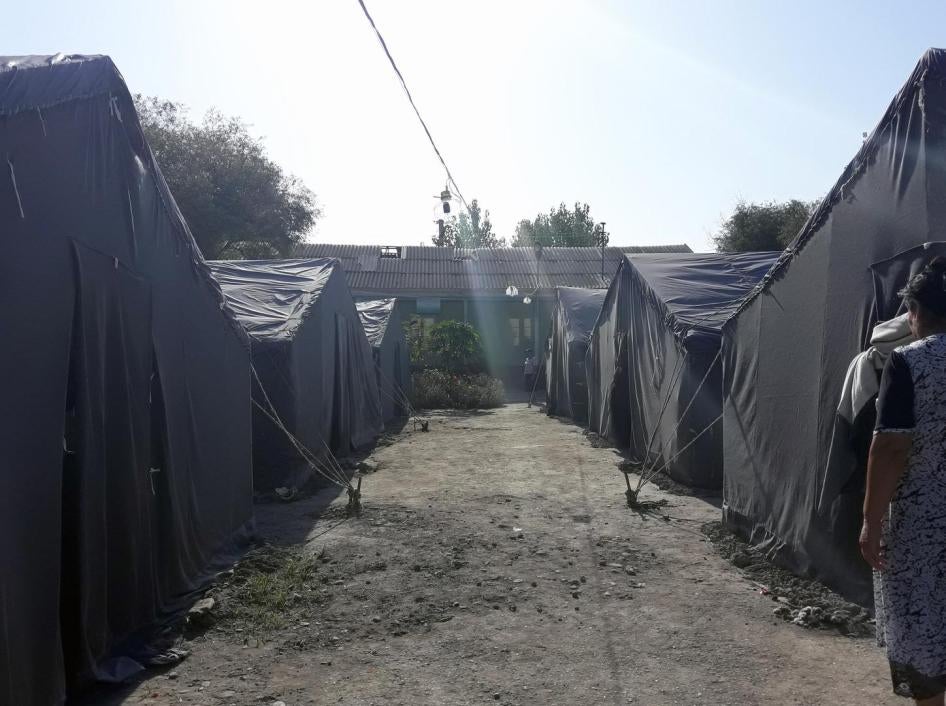
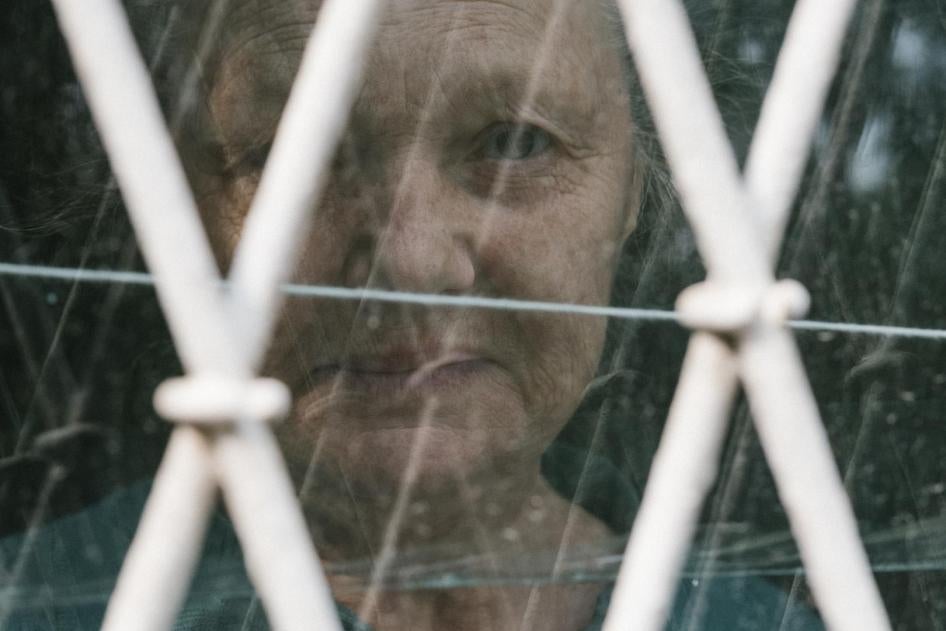
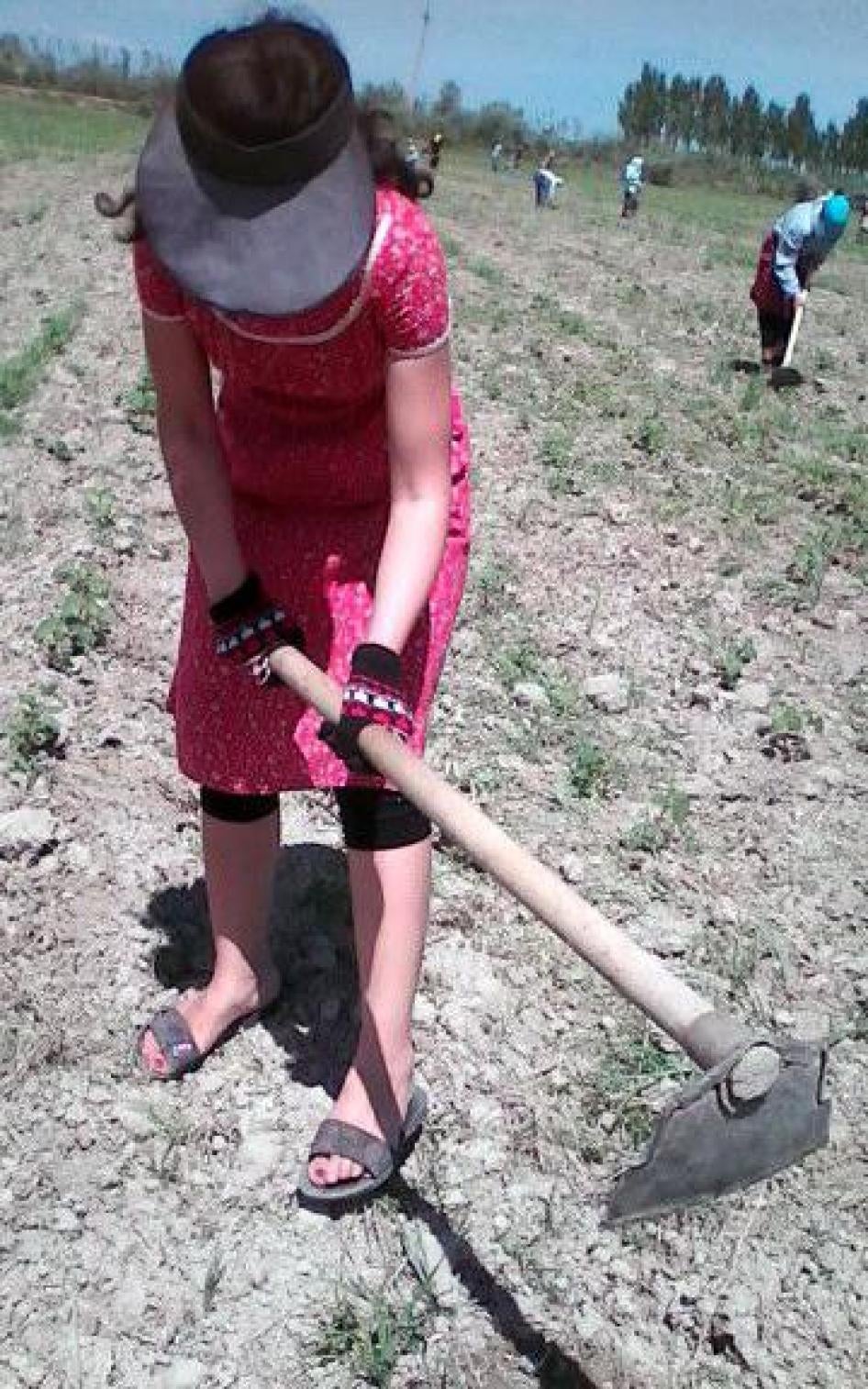
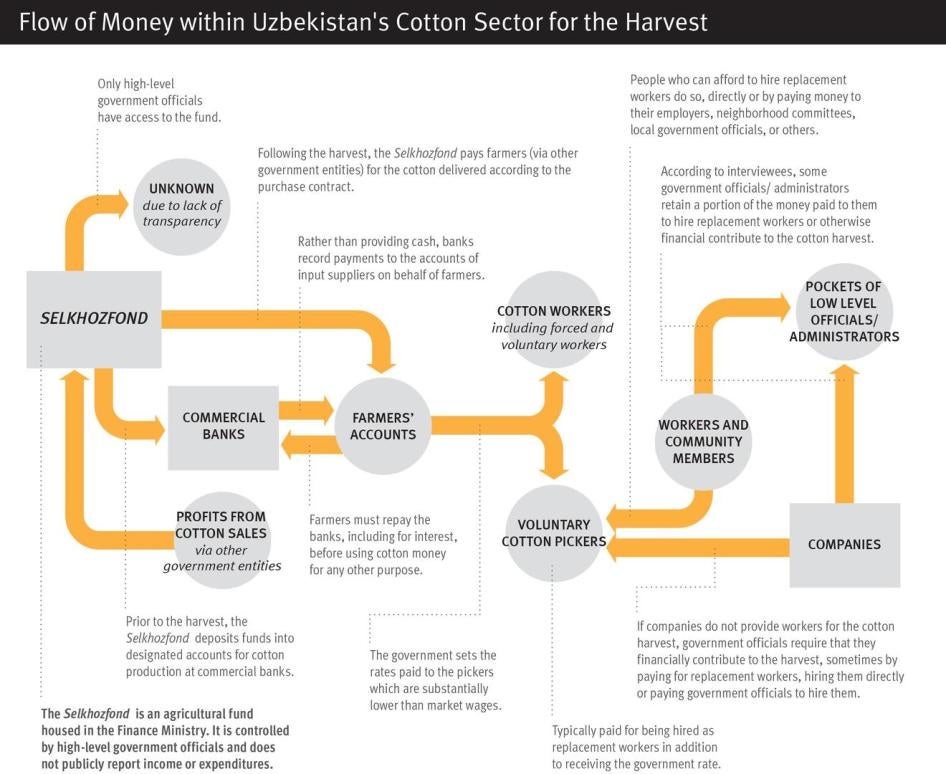
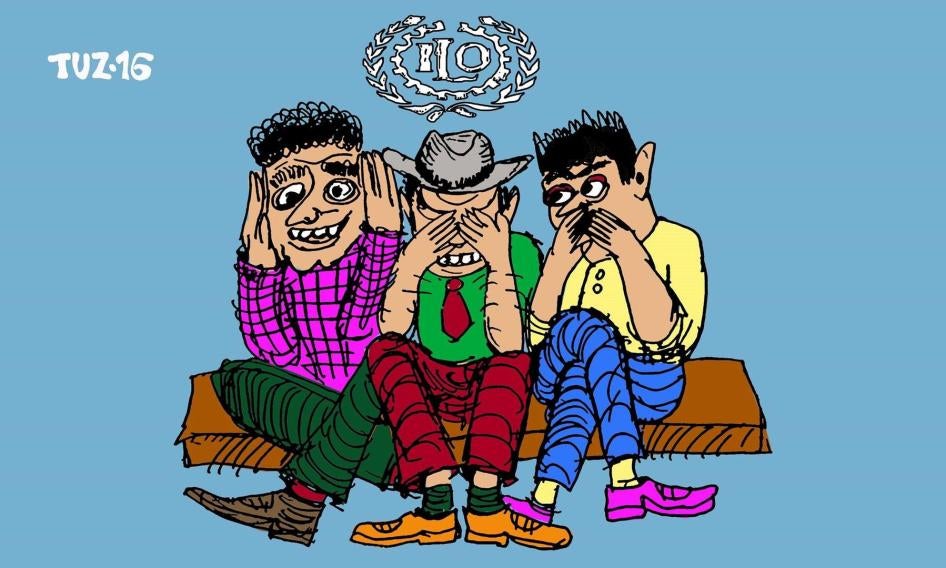
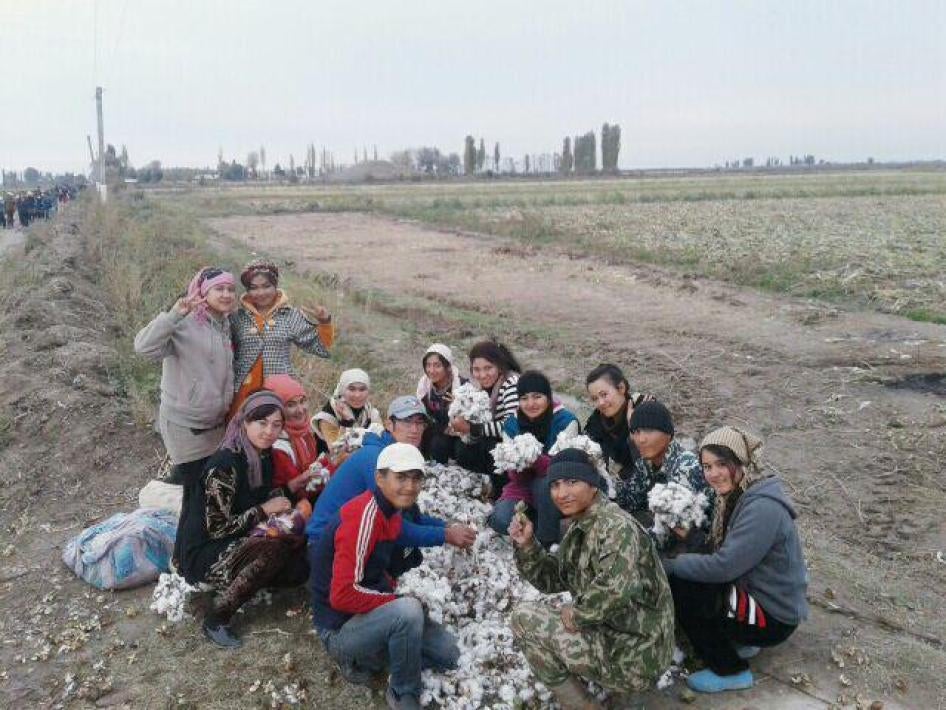

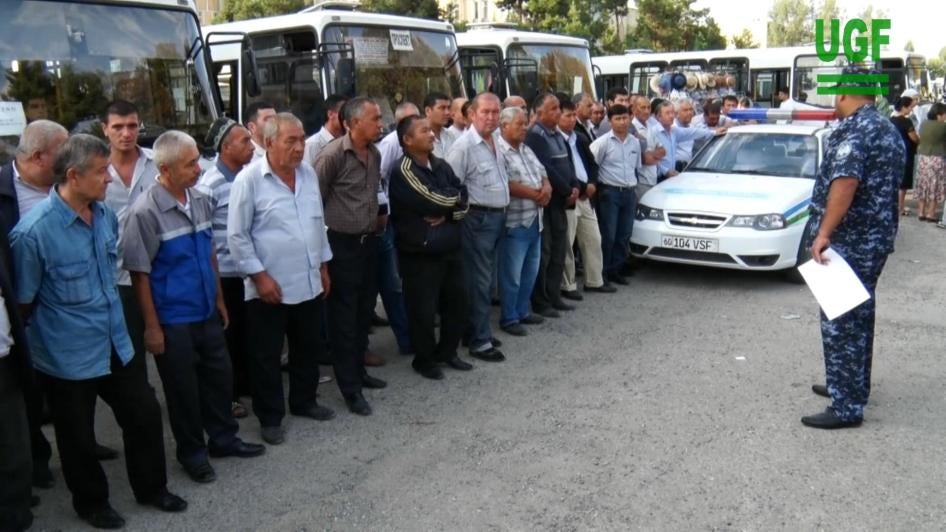

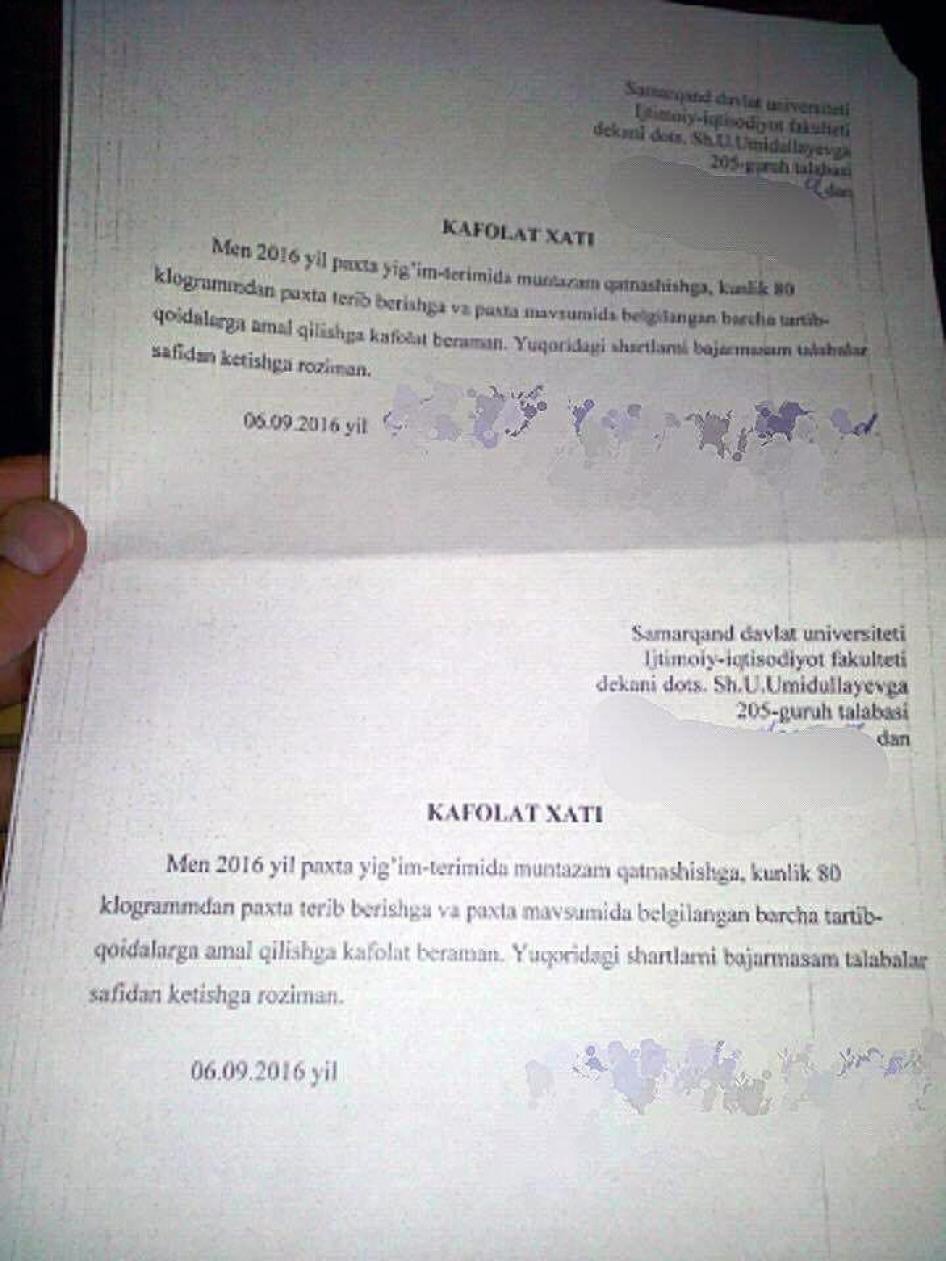
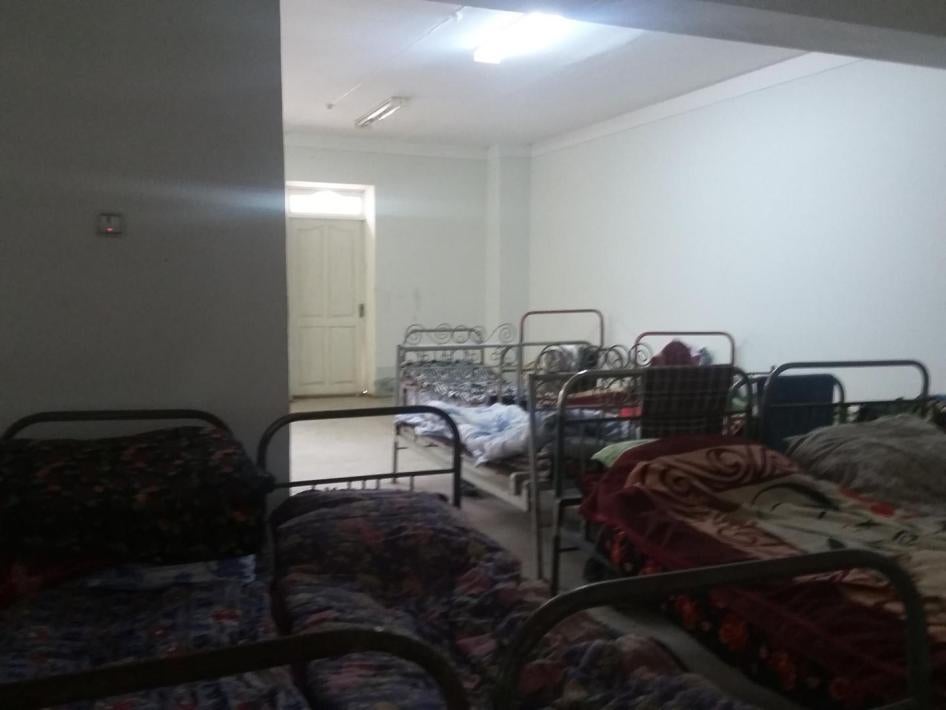
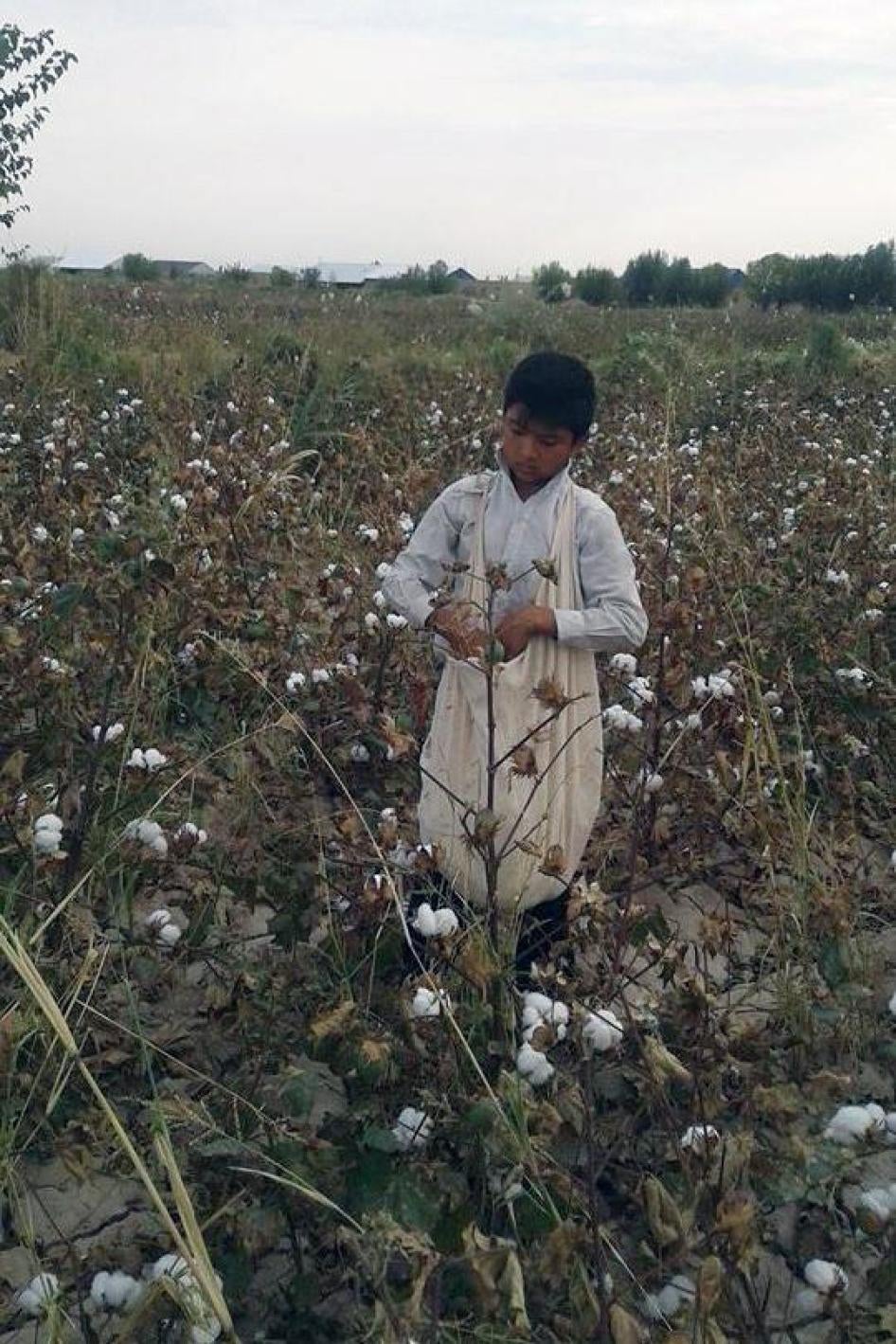
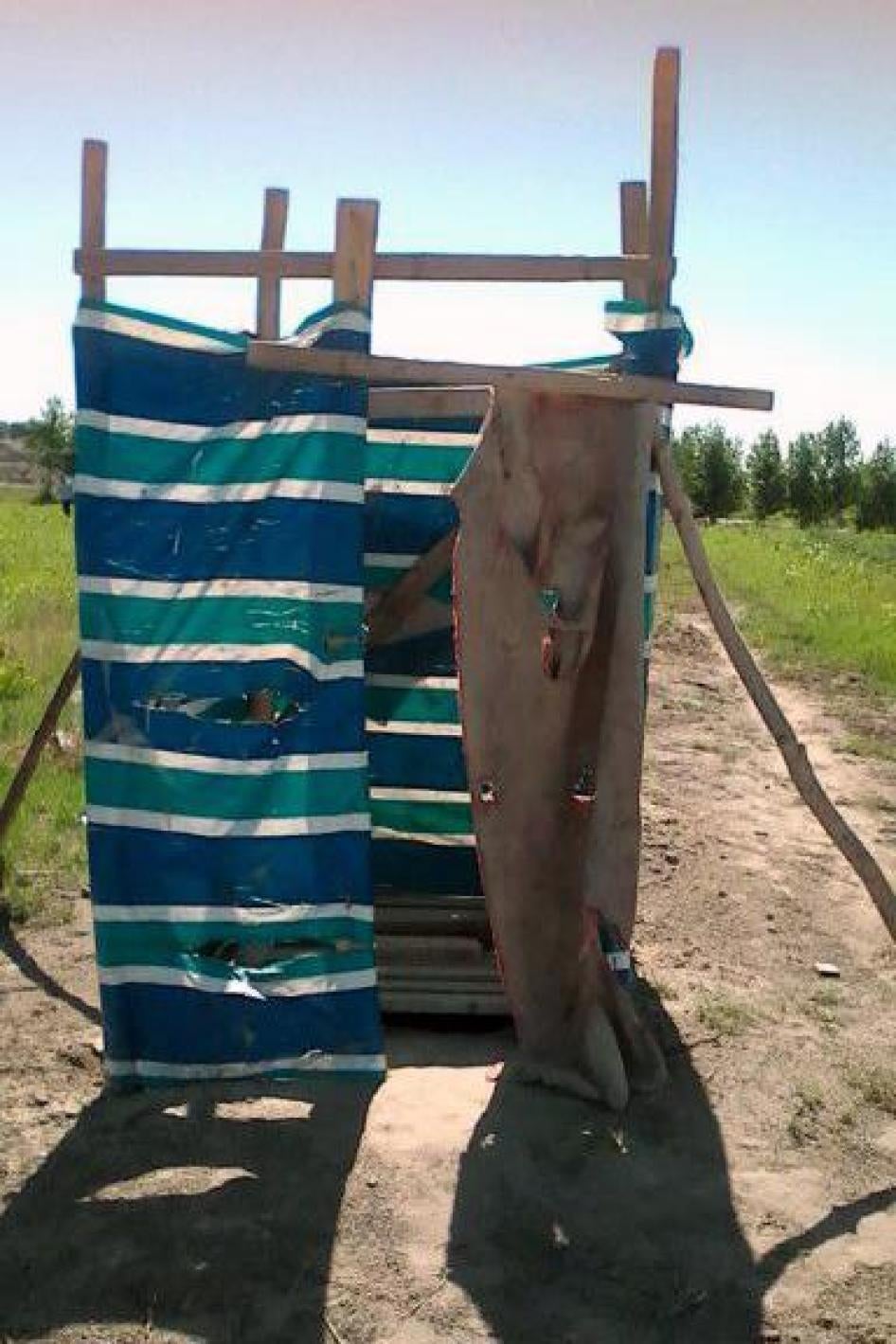
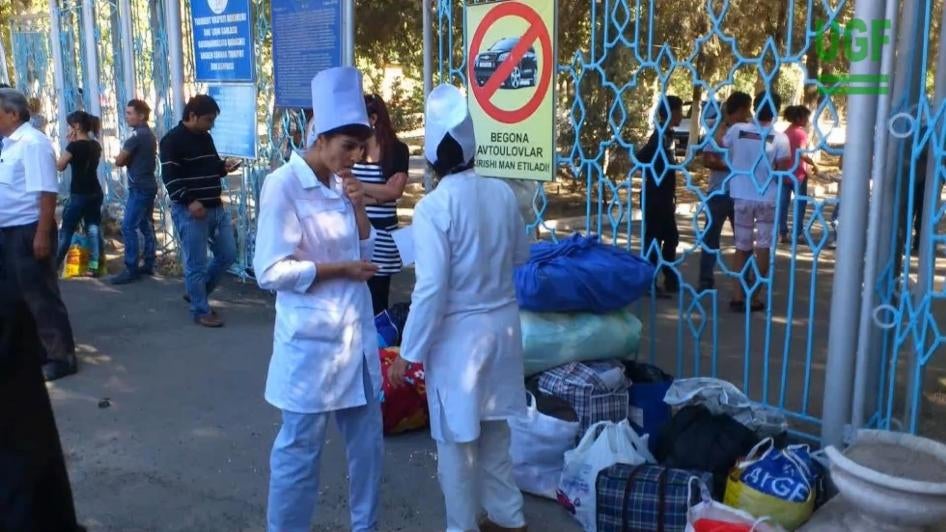
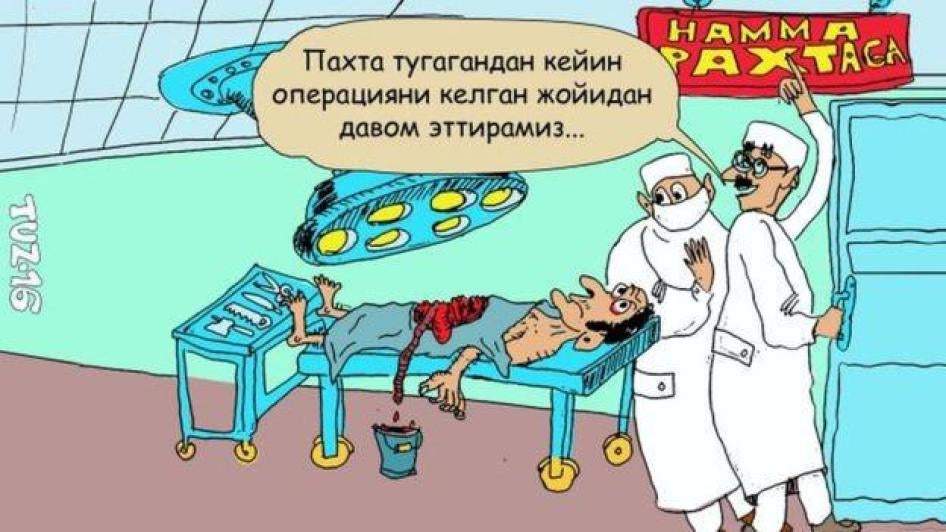
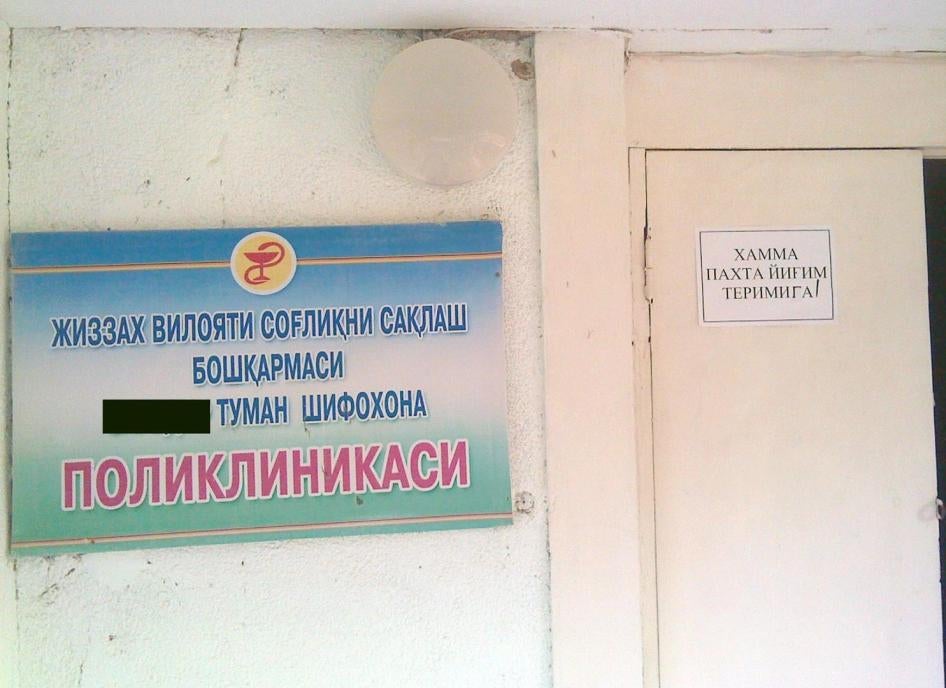
![A public enterprise, Andijan region, September 30, 2016. The sign on the door reads, “Everyone is at the cotton [harvest].”](/sites/default/files/styles/embed_xxl/public/multimedia_images_2017/201706business_uzbekistan_photo_cotton_17.jpeg?itok=j497vG7n)
